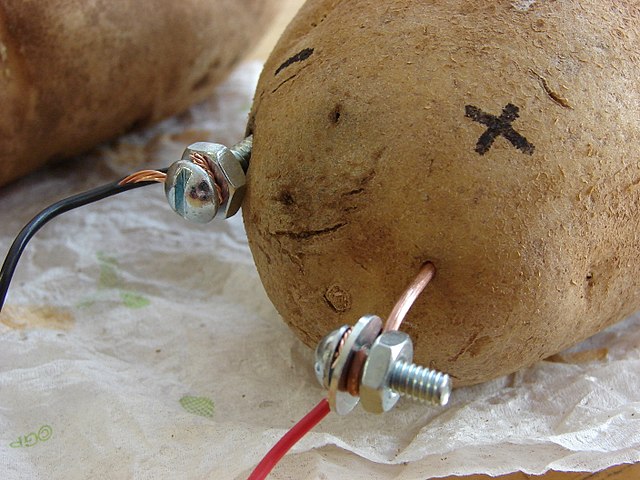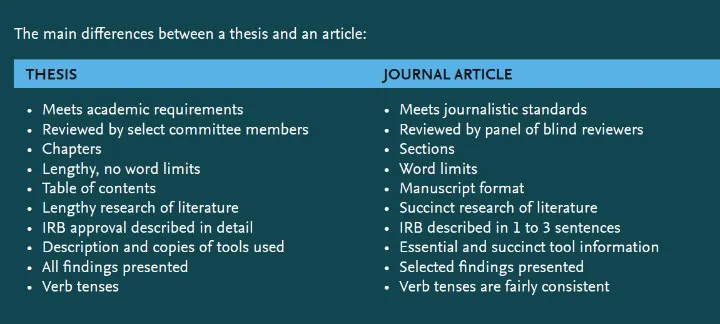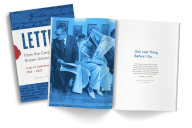

Adapting a Dissertation or Thesis Into a Journal Article
Dissertations or theses are typically required of graduate students. Undergraduate students completing advanced research projects may also write senior theses or similar types of papers. Once completed, the dissertation or thesis is often submitted (with modifications) as a manuscript for publication in a scholarly journal. Thus, the dissertation or thesis often provides the foundation for a new researcher’s body of published work.
Writers will first want to determine whether the work in their dissertation or thesis merits publication. If it does, we then provide guidance on how to adapt a dissertation or thesis for submission to a journal.
Adapting a dissertation or thesis into a journal article is covered in the seventh edition APA Style Publication Manual in Section 12.1
Deciding to submit a dissertation or thesis for publication
When deciding whether to publish the work in your dissertation or thesis, first consider whether the findings tell a compelling story or answer important questions. Whereas dissertations and theses may present existing knowledge in conjunction with new work, published research should make a novel contribution to the literature. For example, some of your original research questions might be suitable for publication, and others may have been sufficiently addressed in the literature already. Likewise, some of your results may warrant additional experiments or analyses that could help answer the research questions more fully, and you may want to conduct these analyses before seeking publication.
You may also want to consider such factors as whether the current sample size provides sufficient power to adequately inform the analyses and whether additional analyses might clarify ambiguous findings. Consultation with colleagues can help evaluate the potential of the manuscript for publication as well as the selection of an appropriate journal to which to submit it. For information on selecting and prioritizing a journal (and tips for avoiding predatory or deceptive journals), see Sections 12.2 to 12.4 of the Publication Manual .
Adapting a dissertation or thesis for publication
Once a decision is made to convert your dissertation or thesis into a manuscript for submission to a journal, you will want to focus attention on adapting it for publication. By attending to brevity and focus, writing style, relevant literature review and data analyses, and appropriate interpretation of the results or findings, you can enhance the fit of your manuscript for journal publication. Editors and reviewers readily recognize an article that has been hastily converted; careful attention when reformatting the dissertation or thesis is likely to increase the manuscript’s potential for serious consideration and eventual publication.
There are several steps writers seeking to prepare their dissertation or thesis for publication can take beforehand:
- Look at articles in the field and in relevant journals to see what structure and focus are appropriate for their work and how they are formatted.
- Request and consider the input of advisors, colleagues, or other coauthors who contributed to the research on which the dissertation or thesis is based.
- Review an article submitted to a journal alongside their advisor (with permission from the journal editor) or serve as a reviewer for a student competition to gain firsthand insight into how authors are evaluated when undergoing peer review.
The original research reported in a dissertation and thesis can then be reformatted for journal submission following one of two general strategies: the multiple-paper strategy or the conversion strategy.
Multiple-paper strategy
The quickest strategy for converting (or “flipping”) a dissertation or thesis into one or more publishable articles is to use a multiple-paper format when initially writing the dissertation or thesis. This involves structuring the dissertation or thesis used to fulfill the requirements for a degree as a series of shorter papers that are already formatted for journal submission (or close to it). These papers are usually each the length of a journal article, conceptually similar, and come from the same overarching project—but can stand alone as independent research reports. Consult your university’s editorial office to confirm that this is an approved format for your dissertation or thesis and to obtain the specific guidelines.
Conversion strategy
A second strategy is to reformat and convert a dissertation or thesis into a journal article after completing your dissertation or thesis defense to fit the scope and style of a journal article. This often requires adjustments to the following elements:
- Length: Brevity is an important consideration for a manuscript to be considered for journal publication, particularly in the introduction and Discussion sections. Making a dissertation or thesis publication-ready often involves reducing a document of over 100 pages to one third of its original length. Shorten the overall paper by eliminating text within sections and/or eliminating entire sections. If the work examined several research questions, you may consider separating distinct research questions into individual papers; narrow the focus to a specific topic for each paper.
- Abstract: The abstract may need to be condensed to meet the length requirements of the journal. Journal abstract requirements are usually more limited than college or university requirements. For instance, most APA journals limit the abstract length to 250 words.
- Introduction section: One of the major challenges in reformatting a dissertation or thesis is paring down its comprehensive literature review to a more succinct one suitable for the introduction of a journal article. Limit the introductory text to material relating to the immediate context of your research questions and hypotheses. Eliminate extraneous content or sections that do not directly contribute to readers’ knowledge or understanding of the specific research question(s) or topic(s) under investigation. End with a clear description of the questions, aims, or hypotheses that informed your research.
- Method section: Provide enough information to allow readers to understand how the data were collected and evaluated. Refer readers to previous works that informed the current study’s methods or to supplemental materials instead of providing full details of every step taken or the rationale behind them.
- Results section: Be selective in choosing analyses for inclusion in the Results section and report only the most relevant ones. Although an unbiased approach is important to avoid omitting study data, reporting every analysis that may have been run for the dissertation or thesis often is not feasible, appropriate, or useful in the limited space of a journal article. Instead, ensure that the results directly contribute to answering your original research questions or hypotheses and exclude more ancillary analyses (or include them as supplemental materials). Be clear in identifying your primary, secondary, and any exploratory analyses.
- Discussion section: Adjust the discussion according to the analyses and results you report. Check that your interpretation and application of the findings are appropriate and do not extrapolate beyond the data. A strong Discussion section notes area of consensus with and divergence from previous work, taking into account sample size and composition, effect size, limitations of measurement, and other specific considerations of the study.
- References: Include only the most pertinent references (i.e., theoretically important or recent), especially in the introduction and literature review, rather than providing an exhaustive list. Ensure that the works you cite contribute to readers’ knowledge of the specific topic and to understanding and contextualizing your research. Citation of reviews and meta-analyses can guide interested readers to the broader literature while providing an economical way of referencing prior studies.
- Tables and figures: Make sure that tables or figures are essential and do not reproduce content provided in the text.
- Research Process
- Manuscript Preparation
- Manuscript Review
- Publication Process
- Publication Recognition
- Language Editing Services
- Translation Services

How to Write a Journal Article from a Thesis
- 3 minute read
- 236.9K views
Table of Contents
You are almost done with your PhD thesis and want to convert it into a journal article. Or, you’re initiating a career as a journal writer and intend to use your thesis as a starting point for an article. Whatever your situation, turning a thesis into a journal article is a logical step and a process that eventually every researcher completes. But…how to start?
The first thing to know about converting a thesis into a journal article is how different they are:
Thesis Characteristics:
- Meets academic requirements
- Reviewed by select committee members
- Contains chapters
- Lengthy, no word limits
- Table of contents
- Lengthy research of literature
- IRB approval described in detail
- Description and copies of tools used
- All findings presented
- Verb tenses may vary
Journal Article Characteristics:
- Meets journalistic standards
- Reviewed by a panel of “blind” reviewers
- Word limits
- Manuscript format
- Succinct research of literature
- IRB described in 1 to 3 sentences
- Essential and succinct tool information
- Selected findings presented
- Verb tenses are fairly consistent
Converting your thesis to a journal article may be complex, but it’s not impossible.
A thesis is a document of academic nature, so it’s more detailed in content. A journal article, however, is shorter, highlighting key points in a more succinct format. Adapting a thesis for conversion into a journal article is a time-consuming and intricate process that can take you away from other important work. In that case, Elsevier’s Language Editing services may help you focus on important matters and provide a high-quality text for submission in no time at all.
If you are going to convert a thesis into a journal article, with or without professional help, here is a list of some of the steps you will likely have to go through:
1. Identify the best journal for your work
- Ensure that your article is within the journal’s aim and scope. How to find the right journal? Find out more .
- Check the journal’s recommended structure and reference style
2. Shorten the length of your thesis
- Treat your thesis as a separate work
- Paraphrase but do not distort meaning
- Select and repurpose parts of your thesis
3. Reformat the introduction as an abstract
- Shorten the introduction to 100-150 words, but maintain key topics to hold the reader’s attention.
- Use the introduction and discussion as basis for the abstract
4. Modify the introduction
- If your thesis has more than one research question or hypothesis, which are not all relevant for your paper, consider combining your research questions or focusing on just one for the article
- Use previously published papers (at least three) from the target journal as examples
5. Tighten the methods section
- Keep the discussion about your research approach short
6. Report main findings in the results
- Expose your main findings in the results section in concise statements
7. Discussion must be clear and concise
- Begin by providing an interpretation of your results: “What is it that we have learned from your research?”
- Situate the findings to the literature
- Discuss how your findings expand known or previous perspectives
- Briefly present ways in which future studies can build upon your work and address limitations in your study
8. Limit the number of references
- To choose the most relevant and recent
- To format them correctly
- Consider using a reference manager system (e.g. Mendeley ) to make your life easier
If you are not a proficient English speaker, the task of converting a thesis into a journal article might make it even more difficult. At Elsevier’s Language Editing services we ensure that your manuscript is written in correct scientific English before submission. Our professional proofers and editors check your manuscript in detail, taking your text as our own and with the guarantee of maximum text quality.
Language editing services by Elsevier Author Services:

How to Choose a Journal to Submit an Article

How to Submit a Paper for Publication in a Journal
You may also like.

How to Write a Cover Letter for Your Manuscript? Here are the Tips and Examples

Publishing Biomedical Research: What Rules Should You Follow?

Writing an Effective Cover Letter for Manuscript Resubmission

Journal Acceptance Rates: Everything You Need to Know

Research Data Storage and Retention

How to Find and Select Reviewers for Journal Articles

How to Request the Addition of an Extra Author Before Publication

Paper Rejection: Common Reasons
Input your search keywords and press Enter.
- Resources Home 🏠
- Try SciSpace Copilot
- Search research papers
- Add Copilot Extension
- Try AI Detector
- Try Paraphraser
- Try Citation Generator
- April Papers
- June Papers
- July Papers

How to Convert Your Thesis into a Journal Article?

Table of Contents
“Congratulations, your Thesis has been accepted!”
Upon submitting your thesis, when you hear this statement, your heart must have felt complete feelings of joy and pride. You must be in a self-boasting mode where you finally feel that you have sent your baby to the outside world. However, as time passes by, you will gradually get to know that: the majority of the researchers only prefer to read a 10-15 page paper about the most revolutionary part of your research rather than digging through 500 pages of your book-style thesis.
Welcome to the harsh reality, now. After completing the gigantic task of writing, submitting, and defending your Ph.D. thesis, you get to know that it was not enough. The next pragmatic step you must adopt is converting a few parts of your thesis into a journal article.
You can easily create a few journal articles by scouring through your manuscript. While skimming your thesis manuscript, you will be able to discover that a few chapters can easily be segmented and converted into a journal article. These segmented chapters and the research material you gathered during the research phase can provide you with enough materials to create a few journal articles.
There is much confusion around the conversion of the thesis to a journal article. These confusions range from “what is the need for the conversion of the thesis to an article,” “whether it is legit to do so or not,” to “is converting a thesis to a journal considered a plagiarized source, specifically self-plagiarism?”
Even you must have got these questions. So, let me answer and clear off the doubts over these looming questions contesting within you.
Why Publish Articles from Thesis?
It is pretty well known that a research paper asserts much credibility to the author. So, the easiest way to create your first research paper is through your thesis or dissertation. Besides, you will come across many benefits once you have published the first article from your thesis. These can include:
1) Career Boost
A mere bullet point mentioning you have authored a journal article will be an outstanding achievement and addition to your CV. It generally takes a year or two to complete a thesis. Since you have already done the research, you do not need to conduct new research or collect facts. This way, you can save a significant amount of time and publish your research.
Also, like a cherry on a cake, you can create multiple research papers from your thesis. In this way, you will be way ahead of your peers as by the time they will be able to publish one or two articles, you will already be carrying multiple journal articles in your name.
2) Greater Outreach
What happened to your thesis after submission? Probably nothing more than becoming part of your institutions’ archives. It is the usual case with every thesis in most institutions worldwide. However, if you transform that into a journal article, it reaches a far greater audience, surpassing your institution's internal corridors.
3) Self-satisfaction
You have spent a lot of time and effort in creating your thesis. So why not reward your efforts by transforming your thesis into a journal article that can provide a more significant readership, credibility, and praise for your work. Just put in a last-mile effort and convert your thesis into a few journal articles; you can quickly achieve higher recognition and reputation for your work and even yourself. Also, it can help in enhancing your academic and research writing skills.
Is creating articles from a thesis or dissertation legit?
There are a lot of concerns and misconceptions that cloud scholars when it comes to publishing articles from theses. For example, scholars usually get thoughts like if journal publishers accept something that has already been a part of a thesis or dissertation or creating articles from a thesis might come under the purview of a duplicate submission, self-plagiarism, or copyright issues.
I will not say that these questions are entirely baseless or of fault, but publishing articles from a thesis varies in different contexts. What I can frankly say is that publishers are not entirely against publishing articles that have been generated from a thesis. Follow-through below mentioned reasons to understand this:
i) Theses are not formal publications
Most academic publishers do not consider theses or dissertations as formal publications. Theses are published at the institutional level only for internal scrutiny and a little circulation among fellow scholars.
However, if your institution has published your theses through its online channels, then it is prudent for you to inform the academic publisher about this. Staying transparent about the origin of your manuscript with your publisher is the best way to stay away from any unethical practices. The best solution here is to create a citation article for your thesis.
ii) No Copyright Issues
You are the copyright owner when it comes to your thesis. So, when you publish an article from your thesis, there will be no copyright infringement issues. You can register yourself as a copyrights owner if extra protective. In such a scenario, you can create as many articles as possible, and academic publishers will publish them without worrying over any copyright violation.
iii) Duplication and Self-Plagiarism can be easily eliminated
A journal article can be generated easily from a few thesis chapters. Therefore, a journal article that has originated from a thesis or a dissertation is a part of it and not a copy. Additionally, it undergoes a rigorous peer-review process, bringing many differences between an article and your thesis. No one can charge you for duplicating your thesis for a journal article.
Similarly, you can avoid the traps of self-plagiarism by simply citing your thesis/dissertation in the journal paper. Moreover, you can take advantage of quote blocks in sections where you have directly used the same content verbatim as your thesis.
You should inform the publisher that the article has been scoured from your thesis in all of these cases. Moreover, you should furnish them with a copy of your thesis with all the information, such as where and when it was first published, etc. Staying transparent and open about these things with your editor can turn to your advantage as they may help you understand the procedures to be followed to avoid any ethics violations you may not know at that time.
Tips on How to convert your thesis to a journal article
Before mentioning the tips on generating a journal article from your thesis, it is crucial that you first understand a few contrasting aspects of a journal article and a thesis.
First and foremost, the audience or the readers are very different for both the journal article and the thesis. In the case of a thesis, the audience is the institutional committee that evaluates if your thesis is of quality or not. Whereas, for the journal article, the readers are the scientists or scholars of the same domain looking for theories backed with facts and evidence.
Additionally, a thesis is created to serve the educational purpose of achieving a degree. On the other hand, an academic paper/article is published to achieve professional goals like attaining credibility, reputation, and recognition in the academic domain.
A thesis is presented or the format is quite different from a journal article. Like everybody else, you too must have included all that you knew about the topic in your thesis. The purpose of a thesis is to present all the known facts and evidence to manifest your knowledge about a particular subject. Whereas, in the case of journals, you have to manifest your knowledge about the topic in a shorter and precise format.
While creating your first publication, you must be careful to ensure that it includes a concise literature review, calculated methods and methodology section, only the relevant findings and evidence, and a condensed discussion section.
You must draft your first paper after understanding your audience and their questions once they choose to read your article. Simply put, you must know your audience and the answers they will be expecting from your article.
To create your first article from your thesis, keep the above-discussed points in your thoughts and follow through the below-mentioned elements that you revise and amend as per the publication’s requirements.
1) Words limit
Quite pronounced and known to all that a journal article is of much shorter length than a thesis. While a thesis can be 8000-10000 words covering over 200+pages, a journal article can maximum go up to a few thousand words spanning over 5-7pages. Additionally, this length also varies from domain to domain and topic to topic.
Therefore, you must shorten each section very accurately. You need to trim the paragraphs so that the true essence should not get lost, and there should not be any redundancy, too. You must select the key important topics and include them in your academic paper.
2) Abstract
The abstract is the entry point of your academic paper. Therefore, you need to include and present the exciting points of the topic here but briefly. You need to curate it according to the instructions provided by your target journal. You must enquire and ensure whether they require a structured or unstructured abstract. Moreover, there is a growing trend of graphical and video abstracts.
3) Introduction
While writing the introduction, you must present the gaps in your chosen topic that led to the research. Next, you need to write a concise literature review to bring forth the past works and the new results that you aim to find out. In this section, you must specify the research problem and a background check over that topic.
You must have extensively provided details about your chosen methods and methodology in your thesis. However, you can not do the same here. You need to narrow it down to the methodology section, especially the experiments, surveys, and more you have adopted. You are not supposed to present a detailed discussion around the research methodology approach in the journal articles.
You must be aware that a thesis must contain the details of every result with considerable discussions, whereas a journal only contains the result of the main findings. Therefore, while creating the result sections, ensure that you include the results or the findings that directly answer the research question. Also, you must provide hard evidence to back your results. Moreover, strict adherence to the standards of reporting results has to be followed.
6) Discussion
The discussion section of a journal article is meant to provide a brief interpretation of the results to display your understanding of the topic. Ensure that you keep the discussion section of your journal article clear and cut to the point. Be aware that by providing a discussion section, you demonstrate your interest and speculations in the future direction the research topic will adopt.
7) References
Do not just copy-paste the reference or citation list from your thesis to the article. You need to provide the relevant reference and citations you sought when conducting the research. You must ensure that the reference list you are putting here should be relevant to the topic. Sometimes, the academic publishers limit the number of references you can include, so properly enquire beforehand only over the number of references.
Final Words
Publishing articles from the thesis is nowhere prohibited. In reality, if you discuss this idea with your peers, they will encourage you to do it. Just keep in mind the concept of thesis and journal articles, their differences, and the purpose each serves in a different context; you will be able to publish an article from your thesis easily.
The above tips are intended to provide you with a direction to publish articles from your thesis. If you feel overwhelmed by the publisher's requirements or get confused and seek answers, you can come over to the SciSpace (Formerly Typeset) Community. Just submit your questions there, and you will find answers pouring in from experts all over the world. Even now, if you feel that there are certain aspects that this article did not cover, feel free and post your question in the SciSpace Community, and I will make sure that you get your answers ASAP.
Considering you are searching for research platforms that streamline workflows, we highly recommend you take a look at SciSpace discover .

It helps you to find millions of peer-reviewed articles with an option to sort the results based on the publishing date, citation count, and relevance along with easy citing feature with multiple citation format just by a click.
You might also like

Consensus GPT vs. SciSpace GPT: Choose the Best GPT for Research

Literature Review and Theoretical Framework: Understanding the Differences

Types of Essays in Academic Writing - Quick Guide (2024)
- Link to facebook
- Link to linkedin
- Link to twitter
- Link to youtube
- Writing Tips
How to Turn Your Thesis into a Journal Article
4-minute read
- 11th September 2019
If you are writing a PhD thesis , you may be thinking about how to get your work published when you’re done. One option is to convert your thesis – or part of your thesis – into an academic journal article .
And if you want to do this, you’ll need to:
- Pick a journal with a scope that matches your research interests.
- Decide which parts of your thesis you want to use for the article.
- Think about whether to co-author the article with someone else.
- Check the journal publisher’s website for author instructions.
- Have the article proofread by an academic editor.
Let’s look at each of these steps in more detail to see how the process works.
1. Pick a Journal
To maximize your chances of publication, pick a suitable journal. The journal’s scope – i.e., the kind of work it publishes – is the most important factor here.
Specialist journals with a narrower scope may be more open to submissions from early career academics than larger, multidisciplinary journals (simply because there is more competition for Nature than, say, the American Journal of Potato Research ). But the most important thing is that your work fits the research interests and approaches of the publishing journal.
Other things to consider when choosing a journal include:
- Article rejection rate.
- Journal metrics (e.g., the impact factor ).
- Journal reputation (e.g., the turnaround times for acceptance/publication).
For more advice, check out the Think. Check. Submit. campaign.

2. Plan Turning Your Thesis into a Journal Article
A PhD thesis is, typically, a long, detailed account of your research. By comparison, a journal article will usually be more focused.
As such, part of turning your thesis into a journal article involves deciding what you will include. This could be a case of setting out your overall argument in clear, concise terms. Or it could be looking for parts of your PhD research that you could use for standalone articles.
Find this useful?
Subscribe to our newsletter and get writing tips from our editors straight to your inbox.
When planning your article, you will therefore need to:
- Have a clearly defined research question.
- Find the parts of your thesis that are most relevant to your question.
- Summarize the aims, methods, results, and outcomes involved.
- Rewrite key sections to make them self-standing.
- Tweak the article to fit the journal requirements.
The first step, then, is creating a paper outline with the factors above in mind.
3. Consider Co-Authorship
If anyone else made a significant contribution to your research, such as your PhD supervisor, you may want to ask them about co-authoring your article. As well as ensuring academic fairness – i.e., crediting them for the contribution they made – this has a couple of distinct advantages:
- You can benefit from their experience of publishing academic work.
- Having an established name with a good reputation in your field of study on the paper may boost your chances of publication.
Remember, though, anyone credited as an author on an article must have made a significant contribution . If they have not, you may want to mention them in a footnote or an “Acknowledgements” section instead.
4. Check the Author Instructions
Before writing your article, check the journal publisher’s website for author instructions. These should tell you all you need to know about:
- The journal’s submission guidelines (e.g., review by an ethics committee).
- The journal’s style requirements (e.g., word count, terminology)
Make sure to follow these guidelines when preparing your journal article.
5. Have Your Article Proofread
Finally, once you have drafted an article, have someone check it.
Asking a colleague is a good first step, as they may have feedback on content. But you’ll also want to ask a professional proofreader to review your document before submission, thus ensuring it is typo free.
Share this article:
Post A New Comment
Got content that needs a quick turnaround? Let us polish your work. Explore our editorial business services.
5-minute read
Free Email Newsletter Template
Promoting a brand means sharing valuable insights to connect more deeply with your audience, and...
6-minute read
How to Write a Nonprofit Grant Proposal
If you’re seeking funding to support your charitable endeavors as a nonprofit organization, you’ll need...
9-minute read
How to Use Infographics to Boost Your Presentation
Is your content getting noticed? Capturing and maintaining an audience’s attention is a challenge when...
8-minute read
Why Interactive PDFs Are Better for Engagement
Are you looking to enhance engagement and captivate your audience through your professional documents? Interactive...
7-minute read
Seven Key Strategies for Voice Search Optimization
Voice search optimization is rapidly shaping the digital landscape, requiring content professionals to adapt their...
Five Creative Ways to Showcase Your Digital Portfolio
Are you a creative freelancer looking to make a lasting impression on potential clients or...

Make sure your writing is the best it can be with our expert English proofreading and editing.

How to Turn Your Thesis Into a Journal Article
In many cases, publishing thesis is often one of the requirements for graduate students to finish their academic program. Publishing research findings is one of the more important ways to share research data with the scientific community. However, the structure of it is different from that of a research article. In this article, we shall discuss how to turn your thesis to journal article.
Characteristics of a Thesis and a Journal Article
|
|
|
| Reviewed by dissertation or thesis committee members | Reviewed by a panel of peer reviewers |
| Chapter-wise sequencing of research data | Section-wise sequencing of research data |
| No specific word limit | Specific word limit as per journal guidelines |
| Includes table of contents | Follows structured manuscript format |
| All findings are presented | Only selected findings are presented |
| Includes description and copies of tools used | Includes essential and succinct tool information |
Differences Between a Thesis and a Journal Article
While both contain similar sections, you cannot simply publish your thesis research as a journal article. Converting it into a journal article has many steps. It is important to recognize that an article is much shorter than the thesis. However, turning your thesis into a journal article will not be a simple matter of copy and paste. You will need to use the data in your thesis as the starting point for writing your article.
Related: Planning to publish your Ph.D. research in a good journal? Check these journal selection guidelines now!
The many differences between a thesis research and a journal article are as follows:
- A thesis meets academic requirements while a journal article meets journalistic standards.
- The abstract of an article is usually shorter than that of a thesis.
- The introduction in a thesis is used to show that you are familiar with the literature in your chosen field. In a research paper , the introduction is much shorter as it is assumed that your target audience is familiar with the necessary background to understand your work. The introduction to your paper will, therefore, focus more on setting the stage for the data/research output that you are about to present.
- The results section in a thesis will include all your findings. In a paper, this would be too much detail. The data in this section should be only what you need to support your research problem or hypothesis. Often, the results in former may represent two to three different papers.
- The discussion in your paper will be much more focused than in your thesis. It will be guided by the results presented in the paper. Finally, only citations of articles actually mentioned in your paper will be listed in the references section.
Turning Thesis Research to Journal Article
As a researcher, you need to publish your work to advance your career and make contributions to the research field. Now that the differences have been outlined, how do you actually write one?
1. Identify a Suitable Journal
You could start by journal selection . Look at your reference list. Chances are at least some of the papers you read were published in journals whose scope would match your work. Selecting a journal also allows you to tailor the paper to the specific requirements of that journal. Ensure that your research article coincides with the aim and scope of the journal. Understand the journal’s guidelines, recommended manuscript structure, and reference style
2. Reduce Redundant Length of Your Thesis
An important aspect of turning your thesis research to journal article is focusing on the word count without deleting crucial information. In order reduce word count , extract the data that answers just one research question. This should result in a more focused information than your thesis research presented. Discuss results in context with your problem statement-that is the focus of your paper. Good language and structure are crucial – your paper may get rejected even though it contains valuable data if it is difficult to understand. Use your data to tell a coherent story and avoid sweeping conclusions your data cannot support. Ensure that your title matches the contents of your paper. Paraphrase the content without changing the meaning.
3. Modify Introduction as Abstract
Repurpose the introduction as an abstract by shortening your thesis introduction to 100-150 words. Remember to maintain key points of the introduction to hold the reader’s attention. Formulate the introduction and discussion of thesis as basis for the journal article’s abstract. Furthermore, consider combining multiple research questions or focus on just one for the journal article.
4. Focus on Relevant and Selective Information
Since the discussion, methods and methodology, and results section of your thesis is an in-detail explanation of your research, these sections must be kept short while writing in a journal article. Familiarize yourself with the target journal’s standards by referring previously published papers and understanding their format. Most importantly, provide interpretation of main findings in the results section in concise statements or tabular formats. Avoid repeating your results in the discussion section. However, discuss how your findings expand and support previous perspectives of the research. Finally, mention how future studies can build upon your work and address limitations in your study.
5. Limit the Number of References
As your thesis is a work of several years put together, it involves numerous literature reviewing. However, while turning your thesis to journal article, you must include only limited references that are relevant to the research question addressed in the journal article. Focus on using most recent references. Consider using reference management tools such as Zotero, Mendeley, Quiqqa, etc. to make the referencing process easier and efficient.
It is an academic requirement that you publish your data for the benefit of the scientific community. Considering that the structure of journal article is different from the structure of a thesis, turning a thesis to journal article must be done following logical steps as mentioned above.
Did you ever have to convert your thesis to journal article? How did you plan it? What strategies did you use while reducing the word count of your thesis? Let us know in the comments section below! You can also visit our Q&A forum for frequently asked questions related to different aspects of research writing and publishing answered by our team that comprises subject-matter experts, eminent researchers, and publication experts.
I was Searching For This From So Many days. Thank you for Sharing
Thanks! Glad you liked it.
Are we also going to talk Code of Conduct in Research, as authorship is part of the conduct (ethics)?
Regards, Elvia

I guess you are referring to our upcoming webinar on Assigning Authorship & Contributorship | Tips for Researchers. We will be discussing the ethical dilemmas in authorship during the session.
We would request you to register and attend the webinar for additional insights on this topic.
Meanwhile, we would recommend you to share your queries with us on our FREE Q&A forum . In addition, you may download our FREE mobile app to stay updated on the latest resources in research writing and academic publishing.
What about the Topic? we need to rephrase the topic or keep it same with Thesis topic?
Hi Shahid, Thank you for your question. Your thesis topic would be a cumulative title for all the chapters described in your thesis. When you publish your thesis as a journal article, every chapter would be published as an individual article in most cases. You may or may not use the same title that you have used for that particular chapter in the thesis. Your thesis would have chapter names that are more suited to the overall objective of your thesis. On the other hand, your manuscript should ideally have a catchy and search-optimized title highlighting a general perspective. It may not be the same as your thesis title. However, if your thesis chapter title meets the requirement of the manuscript you intend to publish, you can go ahead with the same.
You could also go through our articles on writing good research paper titles: https://www.enago.com/academy/top-10-tips-on-choosing-an-attractive-research-title/ https://www.enago.com/academy/writing-a-good-research-title-things-to-avoid/ https://www.enago.com/academy/write-irresistible-research-paper-title/
Did you get a chance to install our FREE mobile app . Make sure you subscribe to our weekly newsletter: https://www.enago.com/academy/subscribe-now/ .
Hi Dr. Durga, Amazing article and I am sure it will surely help the writers to write more carefully and also plagiarised free.
Greeting from Enago Academy! Thank you for your positive comment. We are glad to know that you found our resources useful. Your feedback is very valuable to us. Happy reading!
i just read the article and also the comments section it’s so helpful. thank you so much for sharing it.. good work!
Thanks a lot for this informational blog which surely going to help the students pursuing the Phd. Nowdays due to assignment burden students started taking the help of professional academic experts. There are many writing services.
Thank you for the very useful article. I will definitely look into it.
Writing a book: needed advice and help at one point. I found enago academy in my search of Answers. You were a Great Help! I hope to use your services again, if I am stuck on correct writing principles! Thank You for being here. K.R. Plante
This helped me a lot; thank you for this informative article.
Thanks for writing such an informative blog which will surely be a great help for the students as well as the institutions
Great article! One question…. should I cite the thesis in the paper? If so, how do I do that efficiently since it would be all over the place?
good, insightful piece of text.
Rate this article Cancel Reply
Your email address will not be published.

Enago Academy's Most Popular Articles

- Old Webinars
- Trending Now
- Webinar Mobile App
Mastering Research Funding: A step-by-step guide to finding and winning grants
Identifying relevant funding opportunities Importance of eligibility criteria Understanding the funder’s perspective Crafting a strong…

- Career Corner
Academic Webinars: Transforming knowledge dissemination in the digital age
Digitization has transformed several areas of our lives, including the teaching and learning process. During…

- Manuscripts & Grants
- Reporting Research
Mastering Research Grant Writing in 2024: Navigating new policies and funder demands
Entering the world of grants and government funding can leave you confused; especially when trying…

How to Create a Poster That Stands Out: Tips for a smooth poster presentation
It was the conference season. Judy was excited to present her first poster! She had…

Academic Essay Writing Made Simple: 4 types and tips
The pen is mightier than the sword, they say, and nowhere is this more evident…
How to Improve Lab Report Writing: Best practices to follow with and without…

Sign-up to read more
Subscribe for free to get unrestricted access to all our resources on research writing and academic publishing including:
- 2000+ blog articles
- 50+ Webinars
- 10+ Expert podcasts
- 50+ Infographics
- 10+ Checklists
- Research Guides
We hate spam too. We promise to protect your privacy and never spam you.
- Industry News
- Publishing Research
- AI in Academia
- Promoting Research
- Diversity and Inclusion
- Infographics
- Expert Video Library
- Other Resources
- Enago Learn
- Upcoming & On-Demand Webinars
- Open Access Week 2024
- Peer Review Week 2024
- Conference Videos
- Enago Report
- Journal Finder
- Enago Plagiarism & AI Grammar Check
- Editing Services
- Publication Support Services
- Research Impact
- Translation Services
- Publication solutions
- AI-Based Solutions
- Thought Leadership
- Call for Articles
- Call for Speakers
- Author Training
- Edit Profile
I am looking for Editing/ Proofreading services for my manuscript Tentative date of next journal submission:

What factors would influence the future of open access (OA) publishing?
Unfortunately we don't fully support your browser. If you have the option to, please upgrade to a newer version or use Mozilla Firefox , Microsoft Edge , Google Chrome , or Safari 14 or newer. If you are unable to, and need support, please send us your feedback .
We'd appreciate your feedback. Tell us what you think! opens in new tab/window
Eight top tips to help you turn your PhD thesis into an article
March 22, 2018 | 5 min read
By Laura Mesquita

Sharing insights from the latest Researcher Academy webinar
Many first-time authors use the research conducted as part of their PhD or even Master’s thesis as a basis for a journal article. While that’s a logical step, the requirements for a thesis differ from those of a paper in a peer reviewed academic journal in very significant ways. Ensuring that you are familiar with these can prove the difference between acceptance and rejection…
Elsevier’s Researcher Academy opens in new tab/window recently hosted a live webinar opens in new tab/window on turning your PhD thesis into an article. In this webinar, Dr. Adolfo Cuevas, Assistant Professor at Tufts University, Dr. Cecily Betz, Editor-in-Chief of the Journal of Pediatric Nursing, and Dawn Nahlen, Publisher at Elsevier, discussed eight golden tips to help you transform your thesis into a research paper for publication in a journal.
Apples and pears
Some of the differences between articles and theses are rather clear – consider word limits and the level of detail you should employ in your study. Others, however, are much less obvious. For instance, verbs in a thesis may be in the future “I will research” and in the past tense “I researched”. In journal articles, authors tend to describe a study that has already taken place and so tenses are much more consistent.
Some other key differences are listed below.

Tip 1. Identify the appropriate target journal
Make sure to read the aims and scope of journals you are interested in to be as certain as you can be that your paper falls within the journal’s scope. If your research falls outside of the aims and scope, look for a more suitable home for your paper – as submitting it there would be a wasted effort. Check each journal’s recommended structure and reference style for articles on its website, typically found in the “guide for authors”, to ensure that your paper is not desk rejected. You might find it useful to look at Elsevier’s Journal Finder tool opens in new tab/window when trying to identify a fit for your article.
Tip 2. Shorten the length of your thesis
Journal articles are typically much shorter than theses (the precise word limit will normally be stated in the guide for authors), so be sure to use a tighter framework and a more compact style. This will mean:
Treating your thesis as a separate, new work
Paraphrasing where needed to express the same idea in different ways
Selecting parts of your thesis to repurpose (not all of it) and focusing on the main points you want the reader to understand
Tip 3. Reformat the introduction as an abstract
Writing an abstract opens in new tab/window can be difficult. Lucky for you, you already have a pretty good place to start. While abstracts in journal articles are usually much shorter (100-250 words) than the average thesis introduction, the two have one thing in common: both should contain all the key elements to command the reader’s attention and encourage them to read further. Using your introduction and part of your discussion as a basis for your abstract can be a good starting point.
Tip 4. Modify the introduction
Your thesis may have more than one research question or hypothesis, which are not all relevant for your paper. Consider combining your research questions or focusing on a single one for the article. Unless otherwise suggested, try to keep the introduction short and to the point. It can also be very helpful to use previously published papers (at least three) from the target journal as examples – try to fit in with the usual “form” for articles in the journal.
Tip 5. Tighten the methods section
Often, there is no need for an overly descriptive methods section. While concerns surrounding reproducibility are becoming increasingly important, you may want to keep your methods section succinct and certainly remember your audience: your peers probably do not need every detail of tried and tested methods. A longer description of methods may be a requirement from your institute or funding body, and it is definitely warranted when innovative methods are deployed, but again: it’s a good idea to use papers previously published in the target journal as examples.
Tip 6. Report main findings in results
Be sure to present all the findings that are relevant to your research question(s) in the results section, before the discussion. If you conducted an exploratory analysis, be sure to provide at least a few concise statements on the findings.

Tip 7. Ensure discussion is clear and concise
A good starting point for a discussion section is an interpretation of your results: What is it that the reader will have learned from your research? Do not repeat your results in the discussion section, instead do the following:
Situate your findings in the literature
Discuss how your findings expand the perspective of the field
Briefly present ways in which future studies can build upon your work, and address limitations in your study
Tip 8. Limit number of references
Unlike your thesis, where you can cite those foundational yet potentially dated sources and anything else you may have learned from, journals do sometimes limit the number of citations. For this reason, it’s important to make sure:
To choose the most relevant (and recent) citations
That the citations are formatted correctly
Pro tip: consider using a reference manager system (e.g. Mendeley opens in new tab/window ) to make your life easier. When you’re picking the most relevant citations or quickly reformatting them, you’ll be thankful you did.
The tips presented here are just a short preview of a truly enlightening 60 minutes with an Elsevier publisher, a thesis supervisor and author, and a journal’s Editor-in-Chief. Be sure to catch the full webinar recording opens in new tab/window , entirely free, at the Elsevier Researcher Academy opens in new tab/window .
Final tip of the day: following the event, in the Researcher Academy Mendeley group opens in new tab/window , the webinar panelists answered the participants’ most burning questions from the Q&A – be sure to check it out!
Contributor

Laura Mesquita
Authors' update - keeping journal authors in touch with industry developments, support and training.


- Customer Reviews
- Extended Essays
- IB Internal Assessment
- Theory of Knowledge
- Literature Review
- Dissertations
- Essay Writing
- Research Writing
- Assignment Help
- Capstone Projects
- College Application
- Online Class
7 Steps to Turn a Thesis Into a Comprehensive Journal Article
by Antony W
June 27, 2024

This is the complete guide on how to turn a thesis into a journal article. Whether your professor has asked you to do this as part of your dissertation or you intend to use your thesis as a starting point for a journal writer, you’ll find this guide useful.
Turning your thesis into a journal article and publishing your research findings is a great way to share your research data with the scientific community. By studying your journal article, other researchers will more than likely gain new knowledge they otherwise wouldn’t have. They might even use your research data as a starting point to investigate an arising issue in your field of study.
Apparently, you can’t publish your thesis as a journal article exactly as it is. While the two papers have the common goal of sharing new knowledge with a relevant community of experts, they differ in the overall structure.
So continue reading to learn how to convert your thesis (or dissertation) into a journal article:
How to Turn a Thesis into a Journal Article
The majority of researchers would rather read a 10-15 page article about the most groundbreaking aspect of your study than wade through 300 pages of your book-style thesis. That’s why it’s important to learn exactly how you can turn a thesis into journal article.
While reading over your thesis work, you’ll see that certain chapters are easy to divide and turn into a journal article . These segmented chapters, together with the research materials obtained throughout the research phase, should give you sufficient information to write a few journal articles that other readers can actually read.
Why Should I Publish Journal Articles Based on My Thesis?
It is quite well established that a research article lends the author considerable credibility. As a result, the simplest method to begin writing your first research paper is to begin with your thesis or dissertation. Additionally, you will get several rewards after you publish the first article based on your thesis. These may include the following:
1. Career Advancement
A simple bullet point stating that you produced a journal paper is an exceptional accomplishment and boost to your CV. A thesis often takes a year or two to finish. Because you have already conducted research and gathered information, you are not required to perform more research or collect additional facts. In this manner, it becomes easier to save considerable amount of time and still publish your findings.
Similarly, you may generate many research articles from your thesis. This will put you much ahead of your contemporaries, since by the time they are able to publish one or two pieces, you will have had many journal publications under your name.
2. Expanded Reach
Do you know what became of your thesis once you submit it? Other than getting credit for the hard work that you put in, it will probably be nothing more than an archive in your institution.
This is customary for all theses at the majority of universities worldwide.
However, if you translate that into a journal paper, it reaches a far larger audience, well beyond the confines of your school.
3. Satisfaction with one’s own actions
You’ve invested much time and work in developing your thesis. Therefore, why not reward your efforts by converting your thesis into a journal article that can attract a larger audience, establish your authority, and garner recognition for your work.
By converting your thesis into a few journal pieces, you may immediately increase the fame and renown of your work, as well as yourself. Additionally, it might aid in the development of your academic and research writing abilities.
Is it acceptable to create articles using a thesis or dissertation?
There are several problems and misunderstandings surrounding the publication of papers based on theses.
For instance, researchers often have concerns about whether journal publishers would accept material that was previously included in a thesis or dissertation, or whether generating articles from a thesis will fall under the jurisdiction of duplicate submission, self-plagiarism , or copyright issues.
We are not saying that these concerns are without merit, but the practice of publishing papers based on a thesis differs according to environment. What we can say with confidence is that publishers are not wholly opposed to publishing papers derived from a thesis.
Consider the following:
1. Dissertation and Thesis are Not Official Publications
The majority of academic publishers do not see theses and dissertations as official publications. More often than not, we get them published at the institutional level for internal review and a limited distribution to other researchers.
However, if your university has published your theses online, you should contact the academic publisher. Transparency with your publisher on the origin of your work is the greatest approach to avoid unethical behavior. The optimal option in this case is to construct a thesis citation article.
2. There Are No Copyright Issues
When it comes to your thesis, you are the exclusive owner of the copyright. As a result, there will be no difficulties with copyright infringement when you publish an article based on your thesis. If you want to be extra cautious, you can register as a copyright owner. In this situation, you can write as many papers as you like, and academic publications will publish them without fear of copyright infringement.
3. You Don’t Have to Worry About S-Plagiarism and Duplicates
You can write a full journal article from a few thesis chapters. Thus, a journal article derived from a thesis or dissertation is an integral component of it, not a duplicate. Additionally, it has to go through a rigorous peer-review procedure , which introduces several distinctions between the article and your thesis. Nobody has the right to charge you for copying your own thesis for a journal article.
Likewise, you may prevent self-plagiarism by simply referencing your thesis/dissertation in the journal article. Additionally, you may utilize quotation blocks in areas where you have used the exact same material verbatim as your thesis.
In each of these circumstances, you should tell the publication that the piece came from your thesis. In addition, you should provide them with a copy of your thesis that includes all pertinent information, such as the location and date of its initial publication.
Maintaining transparency and open communication with your editor about these matters might work in your favor, as they may assist you to understand the protocols to follow in order to prevent any ethics issues that you may be unaware.
Thesis vs Journal Article
Before discussing how to generate a journal article from your thesis, it is critical to grasp the differences between a journal article and a thesis.
To begin with, the audience for the journal article and the thesis are different. For a thesis, the audience is the institutional committee that determines whether your thesis is of sufficient quality. Whereas the readers of a journal article are scientists or experts in the same field who are seeking for hypotheses backed up by facts and proof.
Additionally, students write thesis with the educational goal of earning a degree in mind. On the other hand, an academic paper/article published online is for accomplishing professional objectives such as establishing credibility, reputation, and recognition within the academic area.
The format of a thesis is significantly different from that of a journal article. As with everyone else, you must have incorporated in your thesis everything you understood about the subject. The objective of a thesis is to offer all available facts and evidence in order to demonstrate your understanding of a subject. In the case of journals, you must demonstrate your understanding of the subject in a more concise and clear manner.
How to Convert a Thesis Into a Journal Article
When writing your first article, it is critical to include a succinct literature review, calculating procedures and methodology section, relevant results and evidence, and a condensed discussion part.
You must begin writing your paper by gaining a knowledge of your audience and the queries they will have after reading your piece. Simply, you must understand your audience and the responses they anticipate from your post.
To develop your first journal article from your thesis, keep the themes described above in mind and go through information discussed below:
1. Word Count Restriction
It is self-evident and widely accepted that a journal article is significantly less in length than a thesis. While a thesis may have 8000–10,000 words and stretch 200+ pages, a journal article may contain no more than a few thousand words and span 5-7 pages.
As a result, you must carefully condense each piece. You should reduce the paragraphs to ensure that the essential meaning is not lost and that there is no repetition. You must choose the most critical issues and include them into your writing.
2. Abstract
The abstract serves as the gateway to your academic article. As a result, you must incorporate and express the topic’s most fascinating elements here, yet succinctly. You must curate it in accordance with the journal’s guidelines.
You must inquire and confirm if a structured or unstructured abstract is required. Additionally, there is an increasing tendency in graphic and video abstractions.
3. Introduction
While writing the introduction, you must highlight the gaps in your selected subject that prompted your study.
Following that, you must produce a succinct literature review that summarizes previous research and the new findings that you hope to discover. This part should contain a description of the research challenge and a background check on the subject.
4. Techniques
You must have gone into great depth in your thesis on your selected approaches and methodology. You cannot do the same thing with the journal article.
You should focus on the methodology section, particularly the experiments, surveys, and other methods you used. In journal papers, you are not required to provide a full overview of the study methods used.
5. Conclusions
You must keep in mind that a thesis must detail each result with extensive explanation, but a journal may merely include the results of the major discoveries.
As such, while writing the result sections, ensure that you include only those findings or outcomes that directly address the study question. Additionally, you must give real proof to support your findings. Additionally, full adherence to the rules for reporting outcomes is required.
6. Deliberation
The discussion part of a journal article gives a concise interpretation of the findings in order to demonstrate your grasp of the subject. Ensure that the discussion part of your journal paper is succinct and concise.
Bear in mind that by including a discussion section, you exhibit your interest in and guesses about the study topic’s future trajectory.
7. Bibliography
Do not just copy and paste your thesis’s reference or citation list into the article. You must include all references and citations consulted during the research process. You must ensure that the references you include in this section are pertinent to the issue.
Occasionally, academic publications impose limits on the number of references you may provide, so ask ahead of time about the quantity of references.
There are no rules that bar you from turning your thesis into a journal article. In fact, if you discuss this with your peers, they will urge you to follow through.
Simply bear in mind the distinction between a thesis and a journal article, as well as the function each plays in a particular environment, and you will be able to publish an article from your thesis with ease.
To be clear, the purpose of this guide is to point you in the right way when it comes to writing a journal article from a thesis or dissertation.
If you’re feeling overwhelmed by the publisher’s standards, or if you’re just puzzled and in need of assistance, don’t hesitate to contact us for help. We have professionals who are good in dissertations and journal articles, and they’re readily available to help.
About the author
Antony W is a professional writer and coach at Help for Assessment. He spends countless hours every day researching and writing great content filled with expert advice on how to write engaging essays, research papers, and assignments.

Research Guides
Submit and publish your thesis.
- The Graduate Thesis: What is it?
- Thesis Defences
- Deadlines and Fees
- Formatting in MS Word
- Formatting in LaTeX
- Making Thesis Accessible
- Thesis Embargo
- Review and Release
- Your Rights as an Author
- Re-using Third Party Materials
- Creative Commons Licenses for Theses
- Turning Thesis into an Article
- Turning Thesis into a Book
- Other Venues of Publication
Turning Your Thesis into an Article
Creating an article from your thesis means more than just copying and pasting. The audience for the thesis is your committee whereas for an article it may be fellow researchers, professionals working in the field, policy makers, educators, or the general audience. Your article manuscript will need to be modified accordingly. This section is based on Extracting a journal article from your thesis from Taylor & Francis publishing tips for authors.
Plan the article
Identify the central message that you want to get across. This could be a new theory, novel methodology or original findings. Make sure that your article follows a coherent argument and targets the journal audience.
Decide on the kind of article you want to write - will it be a report, position paper, critique or review? What makes your argument or research interesting? How might it add value to the field?
Select a journal
Selecting the right journal means reaching the audience you intend for your article to speak to. To start identifying potential journals:
- Look at your own bookshelf / reference list. Where have authors published on similar topics?
- Search the library catalogue
- Consult Ulrich’s Web serials database (subscription resource)
- For open access journals specifically - search the Directory of Open Access Journals (DOAJ)
- For student journals - see the Directory of Student Journals at UofT
- Talk to your advisor, colleagues or liaison librarians
Automatic journal finders can recommend a journal based on your manuscript title/abstract:
- Jane: the Journal/Author Name Estimator
- Enago Open Access Journal Finder
- Elsevier journal finder
To further narrow down the list:
- Study the “Aim and Scope” or similar section on editorial policies on the website to evaluate the fit and any specific content requirements;
- Skim through past issues, abstracts, table of contents - are there similar papers that have been published?
- How will your paper be reviewed? The journal’s website should mention the details of peer review process;
- Check details of copyright / license agreements and whether publication before or after your thesis submission is allowed .
Is it a trusted journal or publisher?
How to identify a deceptive publisher? See the Deceptive Publishing Checklist created by U of T.

Write the article
You may choose to approach writing your thesis with an aim to publish it as an article or several articles, known as an integrated/publication-based/sandwich thesis. Alternatively, you can reformat and convert your completed thesis into an article to fit the scope and style of a journal article. In both cases it will be helpful to:
- Carefully read and follow “Author Guidelines” for instructions on on preferred layout, word limits, reference style
- Use the criteria the reviewers will use and make sure your article addresses them
- Request and consider the input of your supervisor, colleagues, or other contributors to the research on which your thesis is based
- Reach out to friends or colleagues to prood-read your manuscript prior to submission
Additional resources on converting your thesis into an article:
- Adapting a Dissertation or Thesis Into a Journal Article by APA
- Eight top tips to help you turn your PhD thesis into an article by Elsevier
- Extracting a journal article from your thesis by Taylor & Francis
- << Previous: Publishing Your Thesis
- Next: Turning Thesis into a Book >>
- Last Updated: Oct 10, 2024 5:26 PM
- URL: https://guides.library.utoronto.ca/thesis
Library links
- Library Home
- Renew items and pay fines
- Library hours
- Engineering
- UT Mississauga Library
- UT Scarborough Library
- Information Commons
- All libraries
University of Toronto Libraries 130 St. George St.,Toronto, ON, M5S 1A5 [email protected] 416-978-8450 Map About web accessibility . Tell us about a web accessibility problem . About online privacy and data collection .
© University of Toronto . All rights reserved. Terms and conditions.
Connect with us

How to turn your dissertation into journal articles
How-to-turn-your-dissertation-into-journal-articles.
Eva Lantsoght, Assistant Professor, Universidad San Francisco de Quito
August 06, 2015
Depending on your institution's guidelines, you will either finish your PhD by having a number of papers accepted for publication, or by writing a "big book"-style thesis.
This post is entirely aimed at those of us who spend months on end delivering a thesis of several hundreds of pages. We might be overly proud of having our baby finally sent out into the world, but then it will dawn upon us: the majority of researchers would prefer to read a 10-page paper about a more specific part of this research than plow through our 400 pages of labor. The only one who would ever want to read through it all and spend an entire week making sense of your thesis is a fellow PhD student….
And thus, for most of us "big book"-thesis-writing-and-publishing folks, we'll need to revisit all our material again after publication of the thesis, and turn it into a number of journal papers.
If you are lucky enough to get into a post-doc position that is fully research-oriented, you have all the time (or at least, you might think you have) to write your papers. If you venture out into the industry, you'll have to do it in your evenings and weekends.
Regardless of the time constraints , it's still extremely valuable to take the step of turning your dissertation into journal papers. Two years past my thesis defense, I'm reaching the end of this process (with a number of papers published, a number in review and a few more to write). Below are some of my observations on the process.
1. Plan for it
After you graduate, life is going to take over. You might be changing jobs, moving to a different place/city/country , and these papers might start to slip to the back of your mind. Take some time while your dissertation is still freshly printed, and ask yourself the following questions:
- Which chapters or subchapters would serve as a good journal paper?
- Which journal should I submit my work to?
- How much time do I think I need for writing this paper?
Then, start planning paper by paper . I’m keeping an overview in a Google docs spreadsheet with the papers, the journals I want to submit to, and the tentative self-imposed deadlines. My goal is to produce six new drafts per year, but some months are entirely filled with dealing with reviewers’ comments, delivering research reports with new work, or teaching duties. I typically give my co-authors (maximum) a month to send their feedback. The feedback is usually limited, so I might need just a morning to make a few changes, and then submit. I plan to start writing the next paper (or replying to reviewers’ comments and reworking the manuscript) whenever the draft of the previous one is done, so that I create a constant stream of writing, revising, sending to co-authors and submitting.
2. Enlist some good co-authors
Now that you have -hopefully- worked well with your thesis committee members, and implemented their advice to deliver the final draft of your dissertation, is there any part of your research that particularly benefited from their input? If you are planning to write a paper on this topic, consider inviting this committee member to be a co-author.
Writing with authors other than your supervisor will improve your writing, and is typically well-received in most fields. Publishing with different authors shows that you can work across research groups and universities and that you are ready to reach out into the world.
3. Remember that not all papers are born equal
Some papers will roll out from your dissertation in just a few writing sessions . For other papers you'll be sweating and sighing as you try to force a piece of research into a stand-alone narrative. Don't get mad at yourself or your work - just accept this fact as it is. And if the frustration becomes too much, head to the gym, grab some chocolate or do whatever typically relieves your stress.
Have you published several papers from the work in your dissertation? How did you organize this, and what advice would you like to share with me?
Image Credit/Source:Tatiana Popova/Shutterstock

Watch our Webinar to help you get published
Please enter your Email Address
Please enter valid email address
Please Enter your First Name
Please enter your Last Name
Please enter your Questions or Comments.
Please enter the Privacy
Please enter the Terms & Conditions

Enhance your article's visibility: a guide to SEO for journal authors

Your Guide to Publishing

3 article-level metrics to understand your work’s impact

How to write a clinical case report

How to Write A Lay Summary for Your Research

Think. Check. Submit your way to the right journal

10 Ways to Reduce the Word Count of Your Research Paper

Writing for Publication- How Can a Structured Writing Retreat Help?

Infographic: 6 Steps for Writing a Literature Review
Related articles.
Did you know that over 50% of Wiley Online Library traffic comes directly from search engines like Google and Google Scholar
Wiley supports you throughout the manuscript preparation process,
Get a quick understanding of the metrics that matter for your research, what they can show you, and where to find them.
Editor-in-Chief of Clinical Case Reports, Charles Young, discusses what makes a good case report.
Late with a review report? Find out how to handle the situation in this blog post from Andrew Moore, Editor-in-Chief of Bioessays.
Find out more about "Think.Check.Submit", a cross-industry initiative designed to support researchers on the road to publication.
Do you need some guidance on writing concisely? This presentation, originally published on Editage Insights, offers some quick tips to help you keep to your desired word count in academic writing.
Professor Rowena Murray looks back on a recent writing retreat and discusses how such retreats can help overcome writer's block.
This infographic sets out six simple steps to set you on your way to writing a successful and well thought out literature review.

How to Choose Effective SEO Keywords for Your Research Article | How to Write a Journal Article
Find 5 helpful tips about using keywords in your research article to help journals, and your article, be found more easily by researchers.

Helping authors to bypass article formatting headaches
Improving the author's experience with a simpler submission process and fewer formatting requirements. Release of the pilot program, free format submission.
FOR INDIVIDUALS
FOR INSTITUTIONS & BUSINESSES
WILEY NETWORK
ABOUT WILEY
Corporate Responsibility
Corporate Governance
Leadership Team
Cookie Preferences
Copyright @ 2000-2024 by John Wiley & Sons, Inc., or related companies. All rights reserved, including rights for text and data mining and training of artificial technologies or similar technologies.
Rights & Permissions
Privacy Policy
Terms of Use
How to turn your thesis into an article

Adolfo Cuevas

Cecily L. Betz
About this video
The process of writing a manuscript is considerably different from the work undertaken for academic degree requirements. The focus of this module is to provide potential authors, particularly those who have recently completed their graduate studies, with suggestions for converting their academic project/completed thesis into a manuscript.
In this module, Dr Cecily Betz, PhD, RN, FAAN, Editor-in-Chief of the Journal of Pediatric Nursing and Dr Adolfo Cuevas, PhD Assistant Professor of Community Health at Tufts University will share tips on how you can ensure that your thesis becomes publishable.
Watch this module to gain a clear understanding of how to successfully re-write and edit your thesis to transform it into a publishable paper, how to identify the right journal for your work, and how to interpret submission guidelines. Be sure to download the handouts and presentation slides under "downloads" on this page.
About the presenters

Assistant Professor of Community Health and Director of the Psychosocial Determinants of Health (PSDH) Lab, Tufts University
Adolfo G. Cuevas, Ph.D., employs a social and community psychological perspective to investigate the intersection of race/ethnicity, psychosocial stressors, and health-related outcomes in multiple social contexts (e.g., community, health system). Using a variety of methodological approaches (e.g., quantitative and qualitative methods), his work attempts to illuminate the psychological and social influences of health among racial/ethnic minorities.
Dr. Cuevas is primarily interested in the effects of acute and chronic life stressors on physical and psychological health. He has received funding from the Robert Wood Johnson Foundation and Cancer Disparities Research Network to investigate the biobehavioral pathways linking psychosocial stress and overweight/obesity among Hispanic/Latinos and Black Americans. The culmination of this work will lead to the development of effective community-based interventions to strengthen health-related resources that are available within neighborhood environments.
Dr. Cuevas received his Ph.D. in Applied Social and Community Psychology from Portland State University. He attained additional training as a cancer prevention postdoctoral fellow at the Harvard T.H. Chan School of Public Health (2015-2017).
Dr. Cuevas is Director of the Psychosocial Determinants of Health (PSDH) Lab at Tufts University.

Professor of Clinical Pediatrics, Keck School of Medicine, University of Southern California; Director of Nursing Training, USC University Center for Excellence in Developmental Disabilities at Children’s Hospital Los Angeles; Editor-in-Chief, Journal of Pediatric Nursing
Cecily L. Betz, PhD, RN, FAAN is Professor of Clinical Pediatrics, USC Keck School of Medicine, Department of Pediatrics. Dr. Betz is the Nursing Director and Research Director of the USC University Center of Excellence in Developmental Disabilities at Children’s Hospital Los Angeles (CHLA). Dr. Betz' area of specialization is health care transition (HCT) planning and she is a recognized national and international expert in the field. She has written numerous empirical, clinical, and conceptual articles on the topic. She serves as the Co-Chair of the International and Interdisciplinary Health Care Transition Research Consortium that fosters inter-professional collaboration and development of this emerging field of practice and research. She has served as the PI and Co-PI on numerous extramural grants funded by NIH, MCHB, ADD, and CDC. She consults widely at the international and national levels on health care transition planning, and is also the Founding Editor and Editor-in-Chief, Journal of Pediatric Nursing.
8 tips to turn your thesis into a paper
How to turn your thesis into an article slides, how to publish in scholarly journals, writing a scientific paper: from clutter to clarity.
7 steps to publishing in a scientific journal
Language Editing Services
Journal Authors
JournalFinder
Author Services
How to Convert Your Dissertation into a Journal Article
Adapting your thesis into a shorter article.

Converting your dissertation into a shorter academic article in a peer-reviewed scholarly journal is a daunting task that is rarely addressed in the realm of academia.
Many junior academics face challenges when embarking on this process, among them: writer’s block, fear of rejection, and criticism. Familiarize yourself with this important roadmap that outlines how to effectively condense your dissertation into a publishable journal article. You can increase your chances of publication success, as either a novice or seasoned researcher and author, by following these tips below:
Journal identification
First, do a quick self-assessment. Are you fully informed about the specific criteria required to evaluate a scholarly journal’s credibility ? It is important to keep in mind that your journal should:
- Be peer-reviewed
- Have a high academic rigor, ranking, and reputation
- Be indexed in databases that are credible and recognized in the field
- Be in collaboration with editorial board members who are affiliated with reputable, prestigious academic institutions or universities, and
- Have a minimum of 30% acceptance rate criteria or below
Shortening your thesis
Having a strong story with a unique and authentic voice is pivotal for a successful academic publication. Check whether you will be able to turn your original extensive research, which undoubtedly embodies an engaging story, into a shorter and to-the-point academic narrative.
Manuscript reformat
You should have a clear understanding of the differences between a master’s thesis (or a doctoral dissertation) and a journal article in terms of their format , content, and organization. While a dissertation is process-oriented, a journal article is content-oriented. Also, unless advised otherwise by your journal’s format guidelines, your manuscript’s length should generally vary from 3,000 to 5,000 words and your required academic writing manuals should be the most recent edition of the APA writing style (7 th edition) or an alternative writing manual recommended to authors by your target journal (e.g., MLA, Chicago, Harvard, etc.).
Adapt your story arc
The structure of the story in a journal article will be significantly different from that crafted in an academic thesis or a dissertation. For example, keep the literature review section in your journal manuscript relatively brief. When crafting a journal article, focus on the following:
- Theoretical/conceptual framework, and
- Significance and contribution to the field and to the literature.
Your article’s section structure
Develop a clear understanding of how the structure of your journal article should be established. For example, your manuscript should generally comprise three sections. See the specific elements you should include in each part:
Introduction
- Introduction and the context of your research
- Problem statement
- Research questions (for qualitative studies) or hypotheses (for quantitative research)
- Study’s significance to the field
- Conceptual/theoretical framework
- Review of the literature
Method and Design
- Population and sample size
- Procedures of data collection and analysis (i.e., tools, instruments, and materials to gather, analyze, and synthesize data)
- Validity, reliability, generalizability, transferability, and replicability
- Discussions
- Comparison and contrast with the current body of literature
- Implications
- Challenges and limitations
- Recommendations or directions for future research
- Conclusions
- A-ha moments, lessons learned, messages to take in a to-go box, etc.
Thus, whether a novice or an expert author, always ask yourself if you have a thorough comprehension of how to properly incorporate these essential components of each of the three parts into your academic manuscript.
Identify your target audience
Identify who will be reading your work. Do a detailed inquiry of who will benefit from your work, as the goal is for your research to contribute to your field’s literature. Once your target readers are identified, set out to write each part of your journal article accordingly.
Final words
In this blog entry, we have provided you with practical recommendations when setting out to craft your article for publication in a reputable journal. They will guide you in the right direction before, during, and after the writing process. We hope you will find them practical and helpful to get your own unique piece of scholarly work published sooner than anticipated.
- Our Mission and Values
- Journals and Publishers
- Research Authorities
- Foundations and Museums
- Language Experts
- Translation
- Academic Writing Coaching
- Academic Review
- Book Proposal Assistance
- Journal Finder
- Table and Graph Formatting
- Manuscript Preparation
- Grant Services
- Post-Publication Services
- Grant Proposal Assistance
- Publication Support
- Our Seven Step Recipe For Success
- Pricing & Turnaround
- Success Story- Grant Proposal Assistance
- Success Story- Translation
- Success Story: Editing
- Success Story: Publication Support
- Success Story- Junior Scholar
- 'Publication Success' Interview Series: Previous Recordings
- FAQ: People
- FAQ: Projects
- FAQ: Timeline and Pricing
- Author Resources
- Newsletter Archive
- Upcoming Live Events
- Career Advice
Transforming a Dissertation Chapter into a Published Article
By Faye Halpern and James Phelan
You have / 5 articles left. Sign up for a free account or log in.

Istock.com/O_Slad
As a dissertation writer, you are extremely well positioned to produce a publishable journal article because you know the current scholarly conversations on your topic intimately and have figured out ways to intervene in them. In fact, it might seem that the journey from dissertation chapter to journal article ought to be a relaxing day trip: extract the chapter from the rest of the dissertation, delete any references to other chapters and to your new manuscript as itself a chapter, trim as necessary to fit the word limit of your chosen journal, and send it off.
You might round off the day by kicking back and rewarding yourself with an adult beverage. Such thinking is likely to feel intuitively correct because of a common way we conceive of the dissertation’s purpose: to demonstrate to already-certified members of your profession (aka your committee) that you have mastered the fundamental research skills of that profession by carrying out a well-designed and original research project.
But our experience as editors of scholarly journals has taught us that effective chapters and publishable journal submissions have important differences. Indeed, the cumulative effect of those differences makes the two modes closely related but ultimately distinct genres. Consequently, moving from chapter to article is an act not of extraction but of adaptation.
To be sure, the challenges of this generic adaptation are not as great as those involved in adaptations from one medium to another (e.g., Greta Gerwig directing Little Women ), but we believe that thinking about your task as more than an extraction-cum-copyediting will increase your chances for success. In what follows, we will focus on the nexus of writer, audience and purpose in each genre in order to highlight their differences and, thus, help you identify strategies for your adaptation.
To illustrate our points, we will refer to a hypothetical dissertation within our shared field of literary studies: an investigation of the uses of unreliable narration in the British and American modernist novel that seeks to contribute to conversations within the fields of narrative theory and modernist studies. While this one example won’t represent all dissertations in all fields, we hope our commentary on it will help you think through the opportunities and challenges of your own possible adaptations.
Audiences: In-House/Out in the Field
Attending to audience helps identify what are paradoxically the most subtle and most significant differences between the genres -- subtle because their effects are easy to miss, significant because they influence so many other properties of the two genres. You write your dissertation chapters for your committee members, and you write your journal articles for a much larger audience of scholars in your field, most of whom don’t know you from Adam. Since your committee members are representatives of your field, you have reasons to think that writing for them shouldn’t be different from writing for the audience of a scholarly journal. If your committee members judge your work highly, won’t readers for journal articles do the same?
As the adage has it, appearances are deceiving, and thus the answer is “not necessarily.” Your committee members do not apply the same standards to your chapters that they do to others’ journal articles, and readers for journals will not apply the standards of your committee members to your submissions. Understanding why opens up the differences between the two genres.
Let us return to the purpose of the dissertation: to demonstrate to already-certified members of your profession that you have mastered the fundamental research skills of that profession by carrying out a well-designed and original research project. In contrast, the purpose of a journal article is to make a contribution to scholarly conversations about significant issues in a given field that substantially alters the dimensions, directions or stakes of those conversations.
Again, the differences may appear insignificant, but thinking about them, first from your perspective as writer and then from the perspective of your committee members as readers, uncovers their importance. From your perspective, one of the main challenges of writing a dissertation is that you’ve never written one before. Consequently, you’re undertaking a task that you learn how to do only by doing it, a situation that puts you in the Kafkaesque position of being fully ready to write your dissertation only after you’ve finished it. What is true of the dissertation is also true of its individual chapters. It’s therefore unlikely that a simple extraction will be sufficient.
In addition, the criteria for assessing quality in each genre aren’t exactly the same. Your committee members apply three main criteria: 1) Does the chapter answer the so-what question and thus make a worthwhile contribution to the relevant scholarly conversations? 2) Does it demonstrate that you have acquired the skills -- from doing thorough research to analyzing your objects of study to marshaling these materials into a coherent argument -- to do publishable research? and 3) Does it fit well with the rest of the dissertation? For journal reviewers, the question of fit is off the table, and the demonstration of skills is simply a necessary condition. Thus, their main criterion is the answer to the so-what question, and they put an even greater premium on the significance of your answer.
Suppose the writer of our hypothetical dissertation seeks to adapt a chapter on Ernest Hemingway’s A Farewell to Arms that traces the evolution of Frederic Henry’s narration from unreliable to reliable and concludes with a few paragraphs linking this evolution to Hemingway’s innovations with the genre of narrative tragedy. The writer’s committee has applauded the chapter for its insightful close readings of the narration, its move from the fine-grained analyses to a big-picture argument, and its fit with the larger dissertation because it shows how Hemingway adds a distinctive use of unreliability within the period.
But to make the work publishable, the writer would need to adapt the chapter so that it clearly identifies both its central question(s) and the significance of its response to the so-what question. Perhaps the writer would shift the focus so that the dominant question is about Hemingway’s generic innovation with narrative tragedy, creating the need to give more prominence to his handling of the plot. Perhaps the writer would decide to offer a direct comparison/contrast between Hemingway’s handling of unreliability and, say, William Faulkner’s. This shift would of course involve drawing on material from the chapter on Faulkner, but it would also mean deciding on whether to use that material primarily in the service of highlighting Hemingway’s technique or to give it equal standing and thus seek mutual illumination.
The writer’s choices about the central question(s) would also have consequences for how they make the case for the significance of their intervention. Guided by the need to establish that significance, the writer would adjust their treatment of work by other scholars, engaging more or less fully with those discussed in the chapter and even perhaps bringing others into the conversation.
Core Argument: Interdependence/Self-Sufficiency
Since an effective chapter is well integrated into the larger argument of your whole dissertation, it is interdependent with other chapters. Since a journal article, by contrast, is a stand-alone entity, you need to find strategies to move from interdependence to self-sufficiency.
A first step, as noted above, is to identify the presuppositions or ideas from other chapters you and your committee members bring to this one. A second is to identify the elements of the chapter that tie it to the rest of the dissertation. These elements may be extended passages or allusions to what comes before or after, or, indeed, things taken for granted because already discussed.
A third step follows closely from the second: examining whether those elements are crucial to your case for the specific contribution you want the journal article to make. If so, then you need to find a way to include them that will be clear to readers who are not part of your dissertation conversation. If not, you obviously need to delete them, but you should also ask whether deletion by itself will be enough. Perhaps it will reveal a hole that must be filled with other material so the adaptation results in a self-sufficient argument that makes a substantial intervention.
Suppose the writer of the hypothetical dissertation decides to do the comparison-contrast between Hemingway and Faulkner in order to provide mutual illumination. The writer would need to do at least the following: draw on material from the dissertation’s introduction that stakes out the writer’s position in the debates about unreliability, select and refashion material from both the Hemingway and Faulkner chapters to fit the new purposes of the essay, and cut back on the discussions of material not directly related to each author’s use of unreliability. As the writer made these revisions, they would be guided by their purpose of changing conversations about Hemingway’s and Faulkner’s handling of narrative technique.
Voice: Other Scholars’/Yours
What about the dissertation chapter whose contribution to the whole involves a recognizably distinct intervention in a scholarly conversation? Even then, there might be salient differences between the two genres. Journal articles need to let readers know within the first one or two pages what their scholarly intervention is, whereas dissertation chapters often spend many pages laying out what other scholars have said before turning to how they add to that conversation.
Why? Dissertations want you to give equal weight to two sometimes conflicting aims: 1) demonstrating you know the field and 2) making a contribution to it. In demonstrating you know what previous scholars have said (which might also, as an apprentice scholar, feel like paying necessary homage to the leading lights in your field), you are allowed to sideline your own voice for long stretches.
The case is different for journal articles. Even as it’s crucial for you to situate yourself within conversations among other scholars, your voice needs to ring out loud and clear from beginning to end.
In another article , we've recommended thinking of the introduction to a journal article as requiring a “hook and an I”: authors need to provide a scholarly context that allows readers to see how the author’s own intervention advances the field. We cautioned against ignoring one in favor of the other. In adapting a dissertation chapter, you’re more likely to have favored the hook, so you need to emphasize the “I.”
Beyond the introduction, journal articles need you to refer throughout to what other scholars have said concerning different points you make -- you need a hook line -- but you should keep your voice prominent as you play out that line. Strategies include shaping summaries of other scholars’ arguments to highlight your difference from them and using footnotes rather than the body of your essay to bring in work that is related to but not as directly pertinent to your argument. Dissertations allow you to sideline your own voice in other ways. Dissertation chapters often include a myriad of examples. One of us, Faye, has a friend in a history department who told her that she took great pains to include examples from different primary sources to support each claim she made. She carefully chose these examples to demonstrate to her committee members that she had visited many different historical archives, and they were duly impressed.
But journal reviewers of an extracted chapter would be far less impressed. They don’t need you to prove you have done the research. Instead, they need to understand what your argument is and how it offers a substantial answer to the so-what question. If you think of your examples less as a means to underline your argument and more as occasions to advance it, you will be better able to decide how many -- and which ones -- to use.
Scope: For a Chapter/For an Article
Dissertation chapters and journal articles often differ in the scope of their concerns and in the size of the claims they make about their respective arguments. Many dissertations produce their scholarly intervention more at the level of the whole project than at the level of individual chapters. Because chapters are not stand-alone pieces, they can have diverse functions -- some of which have little to do with making a scholarly intervention of the kind found in journal articles. Some chapters can be devoted to providing methodological or theoretical groundwork, others to extending a previous argument by treating more examples that support it. Indeed, when the dissertation makes its intervention through the cumulative weight of the whole, it may not have a single chapter that directly attempts to meet the criteria for journal articles.
Ah, you might think, in that case I’ll just condense my whole dissertation into an article-length piece. But the result is often that no aspect of the article gets sufficient time, leaving reviewers scratching their heads at the leaps in logic and turning up their noses at the inevitably superficial consideration of examples. Your dissertation does more, as a whole, than any journal article, but a single journal article does more than any individual chapter.
We advise a different strategy. Rather than shrink your dissertation to fit, isolate and expand. What are the smaller, original claims you make along the way to making the big one? Maybe you can flesh out one of those claims and clarify its significance by elaborating on the evidence that supports it and bringing in new evidence. Conversely, maybe you have a striking piece of evidence you use in your dissertation that can be analyzed to yield a substantial claim that you hadn’t yet considered.
Your dissertation is not a display case for a single fully formed diamond. It’s a storeroom of gems in various stages of processing, and you are the lapidary.
Fit: For the Dissertation/For the Journal
Finally, although the dissertation gives you the freedom to choose the scholarly conversations you want to respond to, submitting a portion of it to a journal requires finding a match between your choices and the scope of the journal. More often than not, finding that match will involve some adjustment of your chapter.
Suppose the writer of our hypothetical dissertation wanted to submit something to Narrative . Doing so makes good sense because unreliability, a narrative technique that has generated considerable scholarly debate, is a topic of interest to the journal’s readers. But the hypothetical chapter would need to be revised before it would fit with the journal’s mission, which is to publish work that sets up two-way traffic between narrative theory and interpretation.
Consequently, the writer’s submission would need to do more than analyze Hemingway’s uses of unreliability. It would need to link those analyses with one or more issues in the debate about unreliability and indicate how Hemingway’s practice warrants some revisions or extensions of particular positions in the debate, or even perhaps opens up new ways of thinking about unreliability.
We close with a personal anecdote about what we call Genre Conflation Syndrome, the more general condition underlying the assumption that chapters and articles belong to the same genre. Faye vividly remembers the comments an external reader gave her about what she thought was the clever opening of an article she had submitted to a journal. The opening subtly parodied the esoteric, jargon-laden voice of expertise that, in her view, scholars in writing programs often adopted in order to persuade faculty in other disciplines to listen to what they had to say -- a voice she argued in the rest of the article against adopting. The problem was that readers of the article, acting in good faith, put time into struggling to understand this parody, only to find out they needn’t have bothered. The external reader described feeling manipulated and disinclined to trust the author for the rest of the article (which the reader ultimately advised rejecting).
Faye was baffled: it had worked so well as the opening of a talk! She conflated the genres by assuming that talks are just like articles, just shorter and with fewer examples. It was only after Faye thought through the differences in audiences and purposes between talks and articles (e.g., that talks, paradoxically, have more room for an extended display of wit) that she was able to make the adaptations necessary to turn the talk into an article.
We hope our reflections here will enable you to successfully engage in the necessary generic adaptations as you move from chapter to article -- and that such success will inoculate you against any future bouts of Genre Conflation Syndrome.

Trustee Resignation Letters Document the Evolution of Higher Ed
Lauren Zalaznick, a former corporation member at Brown University, discusses what she learned from curating more than
Share This Article
More from career advice.

What to Actually Look for in a Mentor
Contrary to a popular catchphrase, Evan D.

Academia Broke Me
Becoming an academic editor gave me my life back, writes Paulina S.

A Career Option Humanities Ph.D.s Should Consider
Jobs in career advising for grad students call on the natural skills of such Ph.D.s and are both fulfilling and in de
- Become a Member
- Sign up for Newsletters
- Learning & Assessment
- Diversity & Equity
- Career Development
- Labor & Unionization
- Shared Governance
- Academic Freedom
- Books & Publishing
- Financial Aid
- Residential Life
- Free Speech
- Physical & Mental Health
- Race & Ethnicity
- Sex & Gender
- Socioeconomics
- Traditional-Age
- Adult & Post-Traditional
- Teaching & Learning
- Artificial Intelligence
- Digital Publishing
- Data Analytics
- Administrative Tech
- Alternative Credentials
- Financial Health
- Cost-Cutting
- Revenue Strategies
- Academic Programs
- Physical Campuses
- Mergers & Collaboration
- Fundraising
- Research Universities
- Regional Public Universities
- Community Colleges
- Private Nonprofit Colleges
- Minority-Serving Institutions
- Religious Colleges
- Women's Colleges
- Specialized Colleges
- For-Profit Colleges
- Executive Leadership
- Trustees & Regents
- State Oversight
- Accreditation
- Politics & Elections
- Supreme Court
- Student Aid Policy
- Science & Research Policy
- State Policy
- Colleges & Localities
- Employee Satisfaction
- Remote & Flexible Work
- Staff Issues
- Study Abroad
- International Students in U.S.
- U.S. Colleges in the World
- Intellectual Affairs
- Seeking a Faculty Job
- Advancing in the Faculty
- Seeking an Administrative Job
- Advancing as an Administrator
- Beyond Transfer
- Call to Action
- Confessions of a Community College Dean
- Higher Ed Gamma
- Higher Ed Policy
- Just Explain It to Me!
- Just Visiting
- Law, Policy—and IT?
- Leadership & StratEDgy
- Leadership in Higher Education
- Learning Innovation
- Online: Trending Now
- Resident Scholar
- University of Venus
- Student Voice
- Academic Life
- Health & Wellness
- The College Experience
- Life After College
- Academic Minute
- Weekly Wisdom
- Reports & Data
- Quick Takes
- Advertising & Marketing
- Consulting Services
- Data & Insights
- Hiring & Jobs
- Event Partnerships
4 /5 Articles remaining this month.
Sign up for a free account or log in.
- Sign Up, It’s FREE
- Insights blog
Extracting a journal article from your thesis
Top tips from award-winning author.

What should you consider before and during the process of writing an article from your thesis?
We caught up with Marissa Rollnick, winner of a 2018 NARST Distinguished Contributions to Science Education through Research Award, who gave us her advice for those starting out.
Turning your thesis into publications should mark the beginning of your publication career. It is important to publish work post PhD as this makes your research more accessible to others.
One of the most important points to note is that writing an article from a thesis is not simply a task of cutting and pasting. The purpose and format of a thesis or dissertation is very different from that of a journal article or book chapter. The primary audience for the thesis is the examiner, and the student needs to convince the examiner that they have mastered research techniques and understand the arguments they are making. This can make the thesis repetitive and full of detail. The wider audience for the article or book chapter will want to know about the arguments or findings and at the same time be convinced that the findings are authentic and trustworthy.
Post information
Related posts, insights topics.
Selecting articles from a thesis or dissertation depends greatly on the work itself. There may be new theories, methods or findings that are worth sharing and the supervisor’s role is to assist the student in formulating purposes for the paper. There are several steps involved:
Deciding on authorship
Planning the article, selecting a journal, writing the article.
Reviewing the article before submission

Anyone included as an author of a journal article must have made a significant contribution to it . You may need to decide whether this includes your supervisor and agree the order of the authors’ names. Different disciplines have different authorship practices, but in the humanities the principal author is mentioned first.

A single paper in a journal should contain a central message that you want to get across. This could be a novel aspect of methodology that you have used in your PhD study, a new theory, or an interesting modification you have made to theory or a novel set of findings. Decide what this central focus is.
Then create a paper outline bearing in mind the need to:

Isolate a manageable size
Create a coherent story/argument
Make the argument self-standing
Target the journal readership
Change the writing conventions from that used in your thesis
Selecting a journal is a very important step in planning the article. The journal you select should target appropriate readership, be accredited and be accessible to your peers. Start by asking yourself the following questions:
Look at your own reference list. Which journals have you used?
Study the editorial policies of the relevant journals: some are more restrictive than others (e.g. content, research paradigm, article length)
Scan past editions. Are there any similar papers?
Is it a trusted journal? There are several marks of quality and reliability to look out for in a journal, and people may judge your ability to choose appropriate journals to submit to. The Think. Check. Submit. initiative provides tools to help you evaluate whether the journal you’re planning to send your work to is trustworthy.

When selecting your journal think about audience, purposes, what to write about and why. Decide the kind of article to write. Is it a report, position paper, critique or review? What makes your argument or research interesting? How might the paper add value to the field?
When writing the article consider your choice of ‘theoretical framework’ and ‘voice’. Be clear what your article is about, and what it is trying to do. Finally ask your supervisor /co-author to go through the article with the following in mind:

Use the criteria the reviewers will use.
Read and edit acting as a sympathetic friend and mentor.
Ask another colleague or friend who thinks differently to read it.
Get someone to edit it for language and spelling. Many authors use professional proof readers. This is not a sign of weakness as the editor has some distance from the article. This is particularly important if you come from a country where a different language to that of the journal is used.
Marissa Rollnick is professor emeritus in science education at Wits University of Education in Johannesburg, South Africa. She holds a doctorate in science education from Wits University and is a specialist in academic development and science education. Her professional career includes appointments as high school science and maths teacher, teacher educator (William Pitcher college, Swaziland and University of Swaziland), lecturer and professor in chemistry and chemistry education on access programmes and subsequently teacher education at Wits University and science education research at Wits University. She has had various visiting appointments at University of York, UK, Western Michigan University (Fulbright award), USA and University of Cape Town. She is currently also working at the Univerisites of Pretoria and Johannesburg.
Where to next?
If you’ve found these tips helpful make sure you look at:
Our podcast series for researchers – 15 minutes to develop your research career (which includes the episode mentioned in this post)
Our Insights newsletter – the latest news, tips, and resources delivered straight to your inbox.
Share this post on social

6 Simple Steps to Convert a PhD Thesis Into a Journal Article

What can you do with your PhD manuscript after years of research, sweat, tears (at least that was my case) and revisions? Put it on your mom’s bookcase to proudly showcase to all her friends? Use it as a book stopper? As the world of academia involves attracting funds, research, and publishing, you may find yourself asking, is turning your dissertation into a publishable journal article possible? Yes, definitely yes!
The world has become more fast-paced and competitive, and academia is no different. Today, the concept of ‘publish or perish’ has led to a massive pressure to publish your academic work in order to succeed in the world of scholarly research. The advantages are clear, turning a thesis into a journal article is the best opportunity to present your work to a wider audience, which can get you the funds you need for further research and also act as a great marketing tool for job seekers. This constant pressure to publish can hurt quality, however, your PhD thesis has gone through multiple rounds of revisions by supervisors and reviewers to ensure it meets the high quality benchmarks required to earn your doctoral degree. So, converting a thesis to a journal article should be easy, right? Sometimes it is, but not always.
The good thing is that, in most cases, you will be able to publish more than one article from your thesis (I did so by avoiding plagiarism and without overlapping any of the content across the articles). However, there are a few things to consider. First, the legalities of publishing your thesis; most journals will have no issues with this but it is good practice to mention the work in the credits or in the cover letter. Second, the practicalities, which I will cover herewith. A journal article generally presents a rationale from which a research gap was identified, then how the study intends to fill it, the methods, results and discussion, and often a conclusion. This is also included in a PhD thesis. So why don’t we go straight from the degree approval to the submission page of a target journal? It all comes down to the length! PhD theses vary from subject to subject, but they are far longer than a journal article, probably over 10 times the length needed for an article. Here are a few best practices to help you convert your thesis into a journal article
Get the basics right . Does your PhD thesis cover more than one aspect of your research topic? Then each topic should be treated as an independent theme for a journal article. That is, each chapter could potentially be turned into separate journal articles once you make the necessary modifications to comply with structural guidelines (i.e., abstract, introduction, methods, results and discussions).
Focus on the specifics. When describing the methods, a PhD thesis requires all the specifics, but journal articles can make use of citations to reduce the word count, so effectively cite known approaches or standard laboratory procedures.

Paraphrase effectively . The content in a PhD thesis are expected to be thorough, but journal articles shouldn’t be wordy. So paraphrase content from your thesis; I normally discourage direct quotations, so write concise alternatives using your own words to express meaning.
Get some perspective. Discuss what you’re doing with your supervisors and other colleagues that contributed to the work. This may be obvious but they have walked the road longer than you and will be able to provide some great advice.
Consider writing a review article. The work done on understanding a research topic is remarkably time-consuming, and often covers a wide breadth of knowledge. This can be turned into a review article where you summarize the latest contributions to the field. I published one review from my PhD work considering that during the background review process, I decided to focus on a slightly different direction for my work, and it is today my best effort in converting my thesis to a journal article. One thing to remember is that although review articles do not report original research, they can analyze and often link various studies in an innovative way to promote future research.
Select your target journal carefully. We may all want to publish in a high-impact journal, but if the basics of your research are not well covered by the aims and scope of the journal, you will face a rejection even before your article is sent for review. Read the journal guidelines carefully to comply with all the requirements.
We hope these tips help you turn your PhD masterpiece into a publishable journal article. The work is sound, the background is comprehensive, so jump in. You are ready to step into the next level of building your publication list. Good luck!
Paperpal is a comprehensive AI writing toolkit that helps students and researchers achieve 2x the writing in half the time. It leverages 21+ years of STM experience and insights from millions of research articles to provide in-depth academic writing, language editing, and submission readiness support to help you write better, faster.
Get accurate academic translations, rewriting support, grammar checks, vocabulary suggestions, and generative AI assistance that delivers human precision at machine speed. Try for free or upgrade to Paperpal Prime starting at US$19 a month to access premium features, including consistency, plagiarism, and 30+ submission readiness checks to help you succeed.
Experience the future of academic writing – Sign up to Paperpal and start writing for free!
Related Reads:
- 10-Point Manuscript Checklist to Ensure High-Quality Journal Submissions
- How to Write a Research Paper Title
- Good Writing Habits: 7 Ways to Improve Your Academic Writing
- 4 Key Writing Styles and Examples of Academic Writing
How to Write a Cover Letter for Journal Submission
Ai in publishing and the future of academic writing, you may also like, phd qualifying exam: tips for success , ai in education: it’s time to change the..., 9 steps to publish a research paper, self-plagiarism in research: what it is and how..., 6 tips for post-doc researchers to take their..., 8 most effective ways to increase motivation for..., how to make your thesis supervision work for..., how to write a conclusion for research papers..., ethical research practices for research with human subjects, 5 reasons for rejection after peer review.
HOW TO TURN A THESIS TO JOURNAL ARTICLE FOR PUBLICATION : HARYANA JOURNAL OF OPHTHALMOLOGY
- Get new issue alerts Get alerts
- Submit a Manuscript
Secondary Logo
Journal logo.
Colleague's E-mail is Invalid
Your message has been successfully sent to your colleague.
Save my selection
HOW TO TURN A THESIS TO JOURNAL ARTICLE FOR PUBLICATION
Sengupta, Sabyasachi DNB FRCS (G)
Director, Sengupta’s research academy, Chief Vitreoretina Surgeon, Future Vision eye care, Mumbai
Corresponding author Sabyasachi Sengupta, DNB (Gold medalist), FRCS (G) , Director, Sengupta’s research academy, Chief, Vitreoretina Surgeon, Future Vision eye care, Mumbai, Email- [email protected]

Doing a thesis or dissertation during a masters (md/ms) or DNB residency is a colossal task that requires a lot of effort and commitment. Having put in all the efforts to do a good thesis, it is important that you are not content with its submission to the university but strive to publish it in a peer reviewed indexed journal.
DESCRIPTION - THESIS VS ARTICLE
Before we begin to understand how to do this, lets understand the difference between a thesis and scientific publications in a journal. Firstly, a thesis write up is extremely exhaustive and includes a lengthy review of literature; detailed methodology including standard operating procedures if any and every possible result derived using every possible research tool. Secondly, it is usually more than 10,000 words, 10-15 tables, a lot of figures, graphs and illustrations and usually has more than 100 references. And finally, the thesis may answer many relevant clinical questions as part of the entire project.
On the other hand, an article intended to be published in a scientific journal needs to be crisp in writing respecting the IMRAD (introduction, methods, results and discussion) format, within the journal word count, have limited references and answer a specific question that would be of interest to the journal readership. With these differences in mind, you can imagine that a journal manuscript is essentially a précis from the thesis. However, you need to follow certain guidelines when you are looking to convert your thesis to a journal article. Remember that you have all the material for a good article if you have done your thesis well. It’s just a matter of reorganization and goal directed writing to come up with an unbeatable article for a journal, especially if you follow what’s given below.
Now that we understand the basic differences between a thesis and journal article, it will be easy to understand how to go about converting the thesis into an article. Let’s take a step-by-step approach to this process:
- Writing an abstract: A journal article requires you to submit an abstract which is a stand-alone précis for your study findings. A structured abstract is required by most journals with the following sub-headings: Purpose, Methods, Results and Conclusions. You will need to try and highlight the salient points of your study under these sub-headings within a word count between 250 - 350 words depending upon the journal. Remember that the abstract is freely available online, and after the title, the abstract is the most widely read part of your future publication. Hence concentrate on making it the best resume for your study.
- Writing the Introduction: For a thesis, you will write a review of literature and show your exhaustive understanding of the topic. However, the main goal of the introduction of a journal article is to be succinct and narrow down a readers’ attention from what is known to what is unknown about the topic, thus pique their attention and provide a rationale for your study. It is best to restrict the introduction to about 250 - 300 words.
- Writing the Methods: This section is easiest to write since you have done the study already. However, it is by no means a copy - paste job. The main purpose of the methods in a journal article is to show what was done so that someone else can replicate your study. Omit unnecessary details from this section that do not add value to the manuscript. Yet try and retain the essentials. It is important to mention inclusion and exclusion criteria, sample size calculation, study design, execution (what was done at every step) protocols in short, outcome measures and statistical tests used. It is best if you can show the methods in a flowchart so that it is easy for the journal reviewers as well as readers to easily understand what you did by just eye-balling your paper.
- Writing the Results: The thesis write up will have a lot of results with tables and figures for just about every variable you have measured. Remember that journals hate repetition of results in the written text, tables and figures. A practical approach to writing results for a journal article is to mention the demographics first, followed by results of the primary outcome measure and then results from other outcomes you might have measured. Limit the outcomes you report to those that are meaningful for the particular paper. Before writing, understand your results and decide which results will be in written text, which will go into tables and which results are best represented by a diagram, chart, graph or illustration. It is best to restrict the total tables and figures between 5 and 7 to retain readers’ attention. If you find that you are unable to fit everything nicely into the results, then you might consider splitting the data into 2 different papers which will both be equally consequential. Avoid salami slicing which means unnecessarily splitting data into multiple papers.
- Writing the Discussion: There is not much difference between writing the discussion for the thesis and journal article other than the length. Since you are reporting only meaningful results and not every result you found, the discussion is automatically shortened. It is best to discuss the results of your primary outcome measure first followed by others. Limit comparing your particular outcomes to 2-3 previous studies alone. Choose which ones are closest to your methodology and compare - contrast your discussion as to why your results are similar or different from these previous studies.
- References: Restrict the number of references as per the journal instruction to authors. In fact, it is critically important to understand all aspects of the instruction to authors including referencing style, number of references allowed, instruction for figures (dpi, colour scheme, sizing etc.), restriction on number of tables and figures, word limits etc.
- Choosing a journal of choice: This is a critical decision and should be done keeping in mind the merit of your paper, your target audience, the journal reputation, impact factor, scope and rapidity of decision making.
- A checklist approach: There are internationally accepted checklists that can be used to write manuscripts. In my opinion, since you already have exhaustive material, using checklists is the best way to convert your thesis into a great journal article without missing out on any of the above-mentioned points.
In conclusion, turning your thesis into a journal article can be frustrating with frequent rejections from journals if you don't follow the correct approach, but can be enjoyable if your approach is right. These concepts are applicable not only for a thesis but for any manuscript you wish to submit to a journal. Another caveat is that you need to do the thesis well and derive robust results that cannot be easily refuted or doubted. The foundation for this should be laid even before you begin the thesis.
- + Favorites
- View in Gallery
Related Links
- Articles in PubMed by Sabyasachi Sengupta, DNB FRCS (G)
- Articles in Google Scholar by Sabyasachi Sengupta, DNB FRCS (G)
- Other articles in this journal by Sabyasachi Sengupta, DNB FRCS (G)
Related Videos

CONVERT YOUR PHD THESIS INTO JOURNAL ARTICLES
Researchers are under immense pressure to publish. Without publications your career will stagnate and you could find yourself unemployed and unemployable. This difficult situation is often described as “Publish or Perish.” A simple way to get early publications is to convert your PhD thesis into journal articles.
There is significant effort involved to publish PhD thesis work, but the vast majority of the work is already done. You reviewed the literature, planned and carried out the experiment, analyzed the data, and made conclusions. However, writing a thesis is different than writing a journal article. In this guide, we offer tips on how to convert your PhD thesis into journal articles.
Is this Self-Plagiarism?
Self-plagiarism is the reuse of one’s own work. Journals are very active in preventing this type of academic fraud. Logically you are wondering whether converting your thesis into journal articles is indeed self-plagiarism.
Though each journal will have their own specific take on this, generally this is not considered self-plagiarism. In most cases, the copyright for a thesis remains with you, the author. Additionally, the journal articles will be substantially different from your thesis. You may combine chapters, update the literature cited, change the scope to reflect the journal’s audience, and significantly rewrite the text.
It is best practice to cite your thesis, where appropriate, in your journal articles. Also, be up front with the editor when you submit your paper and tell them that you converted portions of your PhD thesis into the article. They can offer guidance.
Experimental Chapters
A good place to start your conversion is to look at each experimental chapter – the chapters describing your methods and research findings. Often, each experimental chapter can be a standalone research article. Reread each experimental chapter and determine if there is enough data to be a research article. If not, try combining experimental chapters together until you have a good enough ‘story’ to be a research article.
Next, you will need to convert these thesis chapters in the actual research articles. Journals have a rigid structure that must be followed. Typically:
Introduction Materials and Methods Results Discussion Conclusions
Journals also have strict word limits, therefore it is likely that you will need to cut out a lot of text during the conversion. Update the introduction and discussion with relevant information and citations to the target audience of the journal. Often, thesis chapters can include very basic information. Know your audience and write for them. Also remember to be concise.
If you are combining experimental chapters, remove redundancies, especially in the materials and methods, results, and discussion. Convert text into figures and tables where you can. Update existing figures and tables to conform with the journal guidelines and to include combined data from the multiple chapters. Be mindful of any figure and table limits of your target journal.
Literature Review
An often overlooked place to convert your thesis into journal articles is the literature review chapter. A lot of effort went into researching the relevant literature for your thesis work. Your academic supervisors and thesis committee members benefitted from reading your literature review, and other researchers in your field can too. You can turn this chapter into a standalone research article – a review article.
First, determine which portions of your literature are relevant. For example, if your thesis focused on a novel experimental method to measure X, then it could make sense to write a literature review about all techniques that measure X – including yours.
Next, pull out the relevant portions of your thesis and use them to form an outline for your literature review article. Modify the text to match your target audience (the journal audience). You will likely identify gaps in your outline. Research the current literature and fill them.
A PhD thesis can have many different reference sources, such as journal articles, books, conference proceedings, and dissertations. Be sure to update your references to include mainly peer-reviewed journal articles.
Publications are usually all that matters to advance your career as a researcher. A good place to start publishing is to convert your thesis into journal articles. By following this guide, you can take your experimental chapters, and your literature review and turn them into published journal articles.
Make the Best Choice for your Research
Sengi helps small and medium-sized businesses get brilliant ocular health discoveries into the hands of your ideal customer. You don’t need to have a specialized writer in-house to turn your research into reality.
Contact Sengi

The Sengi team is led by Dr. Brad Hall, a vision scientist and expert medical writer. A regular peer reviewer for several medical and ophthalmology journals, Dr. Hall has authored a multitude of articles personally, is a successful grant writer, medical writer, and master of the art of simplifying data and statistical analysis. Since launching in 2015, Sengi has provided medical writing and biostatistics analysis expertise to SMBs and researchers around the world that lacked the necessary means to share their scientific breakthroughs outside of the lab. Sengi’s work has enabled these companies to put advanced technology into the hands of those who need them most.
Copyright © Sengi.
This website uses cookies to ensure you get the best experience on our website. Cookie Policy and our Privacy Policy
- Israeli strike in northern Lebanon kills at least 21 people
- UN Security Council voices 'strong concern' for UN peacekeepers after Israeli attacks
- How did a killing at a Sikh temple lead to Canada and India expelling each other's diplomats?
- Florida returning to something like normal after Hurricane Milton
- Biden admin to provide $750 million to North Carolina-based Wolfspeed for advanced computer chips
- Victims of Maine's deadliest shooting start process of suing the Army
- Harris slams Trump for suggesting military handle 'enemy from within' as they vie for Pennsylvania
- This could have been a year of a federal court reckoning for Trump. Judges had other ideas
- Harris announces a new plan to empower Black men as she tries to energize them to vote for her
- US law entitles immigrant children to an education. Some conservatives say that should change
- Walz to unveil Harris' plan for rural voters as campaign looks to cut into Trump's edge
- Soto, Stanton homers back Rodón as Yankees take advantage of wild Guardians to win ALCS opener 5-2
- Lindor homers as Mets stop Dodgers' scoreless streak in 7-3 win, head to NY with NLCS tied 1-1
- Allen and Bills overcome Rodgers' Hail Mary and beat Jets 23-20 to take control in AFC East
- Taylor Swift and Travis Kelce attend Game 1 of ALCS at Yankee Stadium
- Christopher Reeve's kids wanted to be 'honest, raw and vulnerable' in new documentary 'Super/Man'
- Six people accuse Diddy of sexual assault in new lawsuits, including a man who was 16 at the time
- Trump's economic plans would worsen inflation, experts say
- Stock market today: World shares are mixed after Wall St powers to more records
- The Ring of Fire eclipse, in photos
- NASA spacecraft to study Jupiter moon's underground ocean cleared for October launch
- Tech billionaire pulls off first private spacewalk high above Earth
- FACT FOCUS: A look at the false information around Hurricanes Helene and Milton
- FACT FOCUS: Online posts make unfounded claims about a helicopter delivering aid in North Carolina
- US disaster relief chief blasts false claims about Helene response as a 'truly dangerous narrative'
- After the deluge, the lies: Misinformation and hoaxes about Helene cloud the recovery
- FACT FOCUS: Claims that more than 300,000 migrant children are missing lack context
- A look at false and misleading claims from the vice presidential debate
- After 67 days adrift, a Russian man was rescued but his brother and nephew are dead
- Pumpkin weighing 2,471 pounds wins California contest
- Mud, beer and cash: Annual wife-carrying championship attracts competitive couples to Maine
- Witnesses can bear-ly believe the surprise visitor at Connecticut governor's estate
- Woman pleads guilty to trying to smuggle 29 turtles across a Vermont lake into Canada by kayak
- Authorities continue to investigate container suspected of holding dynamite in Tennessee
- Mammogram centers must now inform women about their breast density. Here's how it could affect you
- Tips for keeping your wedding from becoming a political battleground
- Feeling stressed about the election? Here's what some are doing and what they say you can do too
- Don't expect human life expectancy to grow much more, researcher says
- ‘I love you but I hate you.’ What to do when you can’t stand your long-term partner
- What 'training to failure' means and how to incorporate it into your workout
- Newsletters Newsletters AP News Alerts Keep your pulse on the news with breaking news alerts from The AP. AP Top 25 Poll Alerts Get email alerts for every college football Top 25 Poll release. The Morning Wire Our flagship newsletter breaks down the biggest headlines of the day. Ground Game Exclusive insights and key stories from the world of politics. Beyond the Story Executive Editor Julie Pace brings you behind the scenes of the AP newsroom. The Afternoon Wire Get caught up on what you may have missed throughout the day. See All Newsletters
- Likely in its last decade, a Czech coal mine provides fuel for electricity and heat
- A look at life inside Paraguay's overcrowded prisons
- An elephant procession for Dussehra draws a crowd in the former Mysore kingdom
- Trump's small-dollar donor fundraising is beset by confusion and fatigue
- Africans recruited to work in Russia say they were duped into building drones for use in Ukraine
- Trump has long blasted China's trade practices. His 'God Bless the USA' Bibles were printed there
- How Tucson police handled a death like George Floyd’s when leaders thought it would never happen
- A series of deaths and the 'Big Fight': Uncovering police force in one Midwestern city
- South Korean woman sues government and adoption agency after her kidnapped daughter was sent abroad
- Drought is parching the world's largest man-made lake, stripping Zambia of its electricity
- Clean energy workers are desperately needed, but many don't know these jobs exist
- Climate change gave significant boost to Milton's destructive rain, winds, scientists say
- Voters with disabilities are feeling ignored by presidential candidates
- Expect employers to get more picky about who you see for care
- Company recalls nearly 10 million pounds of meat and poultry dishes for listeria contamination
- Tech consultant goes on trial in death of Cash App founder Bob Lee
- Volunteers bring solar power to Hurricane Helene's disaster zone
- A pastry brought to Mexico by British miners is still popular after 200 years
- Leaf-peepers are flocking to see New England's brilliant fall colors
- Who am I? A South Korean adoptee finds answers about the past — just not the ones she wants
- Members of the Kennedy family gather for funeral of Ethel Kennedy
- Hindus in Bangladesh celebrate their largest festival under tight security following attacks
- El Consejo de Seguridad expresa su "fuerte preocupación" por cascos azules tras ataques israelíes
- ONU: Más de 400.000 niños han sido desplazados en Líbano en 3 semanas de guerra
- Ataque de Israel en norte de Líbano mata a 21 personas en edificio de apartamentos, dice Cruz Roja
- Las muertes de migrantes en Nuevo México se multiplican por 10
- Corea del Norte detona partes de carreteras intercoreanas que ya no están en uso, dice Surcorea
- Una Pakistán castigada por la violencia blinda su capital para una gran cumbre asiática de seguridad
- AP Buyline Personal Finance
- AP Buyline Shopping
- Press Releases
- Mideast Wars
- Israel-Hamas War
- Russia-Ukraine War
- Global Elections
- Asia Pacific
- Latin America
- Middle East
- Explaining Election 2024
- Advance vote
- Election results
- Google trends
- AP & Elections
- Global elections
- Election 2024
- U.S. Supreme Court
- Auto Racing
- Movie Reviews
- What to Stream
- Book Reviews
- Celebrity Interviews
- Financial Markets
- Financial Wellness
- The Ancient World
- Newsletters
- Photo Essays
- Photography
- The Americans
- AP Investigations
- Indigenous peoples and climate
- Climate Questions
- Climate Migration
- India Focus
- Artificial Intelligence
- Social Media
- Back to school
- Food & Recipes
Maye day could turn into Maye’s year as Patriots rookie shows promise in first NFL start
New England Patriots quarterback Drake Maye passes the ball during the second half of an NFL football game against the Houston Texans, Sunday, Oct. 13, 2024, in Foxborough, Mass. (AP Photo/Steven Senne)
New England Patriots quarterback Drake Maye (10) looks to pass the ball as offensive tackle Demontrey Jacobs (75) defends during the second half of an NFL football game against the Houston Texans, Sunday, Oct. 13, 2024, in Foxborough, Mass. (AP Photo/Steven Senne)
New England Patriots quarterback Drake Maye (10) carries the ball during the second half of an NFL football game against the Houston Texans, Sunday, Oct. 13, 2024, in Foxborough, Mass. (AP Photo/Steven Senne)
New England Patriots quarterback Drake Maye (10) and Houston Texans quarterback C.J. Stroud (7) meet on the field following an NFL football game, Sunday, Oct. 13, 2024, in Foxborough, Mass. (AP Photo/Charles Krupa)
New England Patriots wide receiver Kayshon Boutte (9) celebrates after his touchdown reception with quarterback Drake Maye (10) and wide receiver Kendrick Bourne (84) during the first half of an NFL football game against the Houston Texans, Sunday, Oct. 13, 2024, in Foxborough, Mass. (AP Photo/Charles Krupa)
Houston Texans safety Eric Murray (23) tackles New England Patriots quarterback Drake Maye (10) on a carry during the first half of an NFL football game, Sunday, Oct. 13, 2024, in Foxborough, Mass. (AP Photo/Steven Senne)
New England Patriots quarterback Drake Maye (10) looks to pass the ball during the first half of an NFL football game against the Houston Texans, Sunday, Oct. 13, 2024, in Foxborough, Mass. (AP Photo/Charles Krupa)
Houston Texans defensive end Will Anderson Jr. (51) sacks New England Patriots quarterback Drake Maye (10) as Patriots offensive tackle Demontrey Jacobs (75) defends during the first half of an NFL football game, Sunday, Oct. 13, 2024, in Foxborough, Mass. (AP Photo/Charles Krupa)
New England Patriots quarterback Drake Maye (10) hands off to running back Antonio Gibson (4) during the first half of an NFL football game against the Houston Texans, Sunday, Oct. 13, 2024, in Foxborough, Mass. (AP Photo/Charles Krupa)
- Copy Link copied

The New England Patriots might just have reason for optimism again.
Five years after Tom Brady played his last game in a Patriots uniform and three seasons after rookie Mac Jones led them to their only playoff appearance since Brady left, Drake Maye awakened the New England offense against the Houston Texans.
It wasn’t nearly enough: The Patriots lost 41-21, their fifth straight defeat. But the 21 points was the most they had scored all season, and Maye also threw for more yards and more touchdowns than Jacoby Brissett had in any of the first five games. (Alas, the 41 points was also the most New England had given up.)
“I was a little amped at the start, for sure,” said Maye, who had appeared in one game in mop-up duty but was making his first career NFL start. “We’ve got some stuff to look back and learn from, but I also feel like we did some good things.”
After trying for three seasons to rebuild from the Brady era with Jones, a 2021 first-round draft pick, the Patriots gave up on him — and six-time Super Bowl-winning coach Bill Belichick — and went back to the draft to select Maye third overall.
But while the Nos. 1 and 2 picks, Caleb Williams and Jayden Daniels, were immediate starters and were already showing success in Chicago and Washington, the Patriots left Maye on the bench for five games to learn behind Brissett.
After opening the season 1-4 behind the journeyman, coach Jerod Mayo made the change.
Maye completed 20 of 33 passes for 243 yards and three touchdowns — the first time New England surpassed 160 passing yards in a game this season. Maye also gave the ball away on a strip-sack and threw two interceptions.
The AP Top 25 college football poll is back every week throughout the season!
Get the poll delivered straight to your inbox with AP Top 25 Poll Alerts. Sign up here .
The progress was evident even as the game went on.
After going three-and-out on his first drive and throwing an interception on his second, he picked up a few first downs on the following possessions and led the Patriots to a touchdown in the final minute of the first half.
“He’s like a natural leader,” receiver Kendrick Bourne said. “He has aura. That’s important in football. Some people have aura, some people don’t, so he’s kind of one of those. He doesn’t have to try, he’s that guy.
“When he’s in the huddle, he knows what he’s doing,” he said. “You can feel it. It’s important.”
What’s working
The two-minute drill.
Maye drove the Patriots 84 yards for a touchdown after taking over at their 16-yard line with 59 seconds left in the first half. He hit Demario Douglas for 22 yards to get some breathing room, then connected with Kayshon Boutte for a 40-yard score.
“I think the two-minute time is a great time for a quarterback to kind of get some passes and get some plays that we’re comfortable with under my belt,” Maye said. “Just get the guys the ball, and that’s the biggest thing I’ve got to do: Get them the ball and let them make plays.”
What needs help
Minimizing damage.
The Texans had two plays that went for more than 50 yards on Sunday: Joe Mixon’s 59-yard second-quarter run that flipped the field (but did not result in Houston points), and Dameon Pierce’s 54-yard touchdown run in the fourth.
“Big plays killed us,” Mayo said. “You take those away and it looks a lot better, but at the same time, that’s what the NFL is. You’ve got to limit those big plays, and then offensively, we have to make big plays.”
The Texans had three runs for at least 20 yards in all, and three more 20-yard pass plays. New England had some big plays of its own, including 40- and 35-yard touchdown passes.
With their sixth offensive line combination in as many games, the Patriots might have found some stability after signing center Ben Brown off the Las Vegas practice squad during the week. He replaced Nick Leverett, who was elevated to the starting lineup when longtime center David Andrews was injured. Leverett was cut on Monday.
“I’ve never seen it before: A guy being able to come in here after four or five days and become the starting center,” Mayo said. “I would say he probably was our best lineman yesterday, and he did a good job for us. He did a good job all through the week during practice, and then went out there and performed pretty well.”
The running game didn’t do much. Maye was the leading rusher, picking up 38 yards on five carries. With Rhamondre Stevenson out due to a foot injury, Antonio Gibson carried most of the load and gained 19 yards on 13 carries. Take away Maye, and the Patriots averaged about 2 yards per rush.
T Vederian Lowe left the game in the first half with an ankle injury and was scheduled for an MRI on Monday.
3 — Maye’s three TD passes in his first career start was quicker than Brady, who did it in his fourth. Mac Jones did it in his 10th and Drew Bledsoe threw for four in his 13th.
What’s next
The Patriots travel to London to face the Jacksonville Jaguars on Sunday.
AP NFL: https://apnews.com/hub/NFL


IMAGES
VIDEO
COMMENTS
Request and consider the input of advisors, colleagues, or other coauthors who contributed to the research on which the dissertation or thesis is based. Review an article submitted to a journal alongside their advisor (with permission from the journal editor) or serve as a reviewer for a student competition to gain firsthand insight into how ...
A thesis is a document of academic nature, so it's more detailed in content. A journal article, however, is shorter, highlighting key points in a more succinct format. Adapting a thesis for conversion into a journal article is a time-consuming and intricate process that can take you away from other important work.
1) Words limit. Quite pronounced and known to all that a journal article is of much shorter length than a thesis. While a thesis can be 8000-10000 words covering over 200+pages, a journal article can maximum go up to a few thousand words spanning over 5-7pages.
Tip 4: Modify the introduction. Be concise! Unless otherwise suggested, keep the introduction short and straight to the point. Use previously published papers (at least three) from the target journal as templates. Your thesis may have more than one research question or hypothesis.
Find the parts of your thesis that are most relevant to your question. Summarize the aims, methods, results, and outcomes involved. Rewrite key sections to make them self-standing. Tweak the article to fit the journal requirements. The first step, then, is creating a paper outline with the factors above in mind. 3.
3. Modify Introduction as Abstract. Repurpose the introduction as an abstract by shortening your thesis introduction to 100-150 words. Remember to maintain key points of the introduction to hold the reader's attention. Formulate the introduction and discussion of thesis as basis for the journal article's abstract.
Tip 2. Shorten the length of your thesis. Journal articles are typically much shorter than theses (the precise word limit will normally be stated in the guide for authors), so be sure to use a tighter framework and a more compact style. This will mean: Treating your thesis as a separate, new work.
Ensure that the discussion part of your journal paper is succinct and concise. Bear in mind that by including a discussion section, you exhibit your interest in and guesses about the study topic's future trajectory. 7. Bibliography. Do not just copy and paste your thesis's reference or citation list into the article.
Write the article. You may choose to approach writing your thesis with an aim to publish it as an article or several articles, known as an integrated/publication-based/sandwich thesis. Alternatively, you can reformat and convert your completed thesis into an article to fit the scope and style of a journal article. In both cases it will be ...
how-to-turn-your-dissertation-into-journal-articles. Eva Lantsoght, Assistant Professor, Universidad San Francisco de Quito. August 06, 2015. Depending on your institution's guidelines, you will either finish your PhD by having a number of papers accepted for publication, or by writing a "big book"-style thesis.
The focus of this module is to provide potential authors, particularly those who have recently completed their graduate studies, with suggestions for converting their academic project/completed thesis into a manuscript. In this module, Dr Cecily Betz, PhD, RN, FAAN, Editor-in-Chief of the Journal of Pediatric Nursing and Dr Adolfo Cuevas, PhD ...
Here are some of the elements that you will need to work on to successfully create a journal article from your thesis:. 1. Length: A journal article is much shorter than a dissertation or thesis, and consequently, requires a tighter framework and a more compact style.While a dissertation can run up to a few 100 pages and has around 20,000 words, a journal article can be anywhere between 3000 ...
Manuscript reformat. You should have a clear understanding of the differences between a master's thesis (or a doctoral dissertation) and a journal article in terms of their format, content, and organization. While a dissertation is process-oriented, a journal article is content-oriented. Also, unless advised otherwise by your journal's ...
Scope: For a Chapter/For an Article. Dissertation chapters and journal articles often differ in the scope of their concerns and in the size of the claims they make about their respective arguments. Many dissertations produce their scholarly intervention more at the level of the whole project than at the level of individual chapters.
Selecting articles from a thesis or dissertation depends greatly on the work itself. There may be new theories, methods or findings that are worth sharing and the supervisor's role is to assist the student in formulating purposes for the paper. There are several steps involved: Deciding on authorship. Planning the article. Selecting a journal.
The advantages are clear, turning a thesis into a journal article is the best opportunity to present your work to a wider audience, which can get you the funds you need for further research and also act as a great marketing tool for job seekers. This constant pressure to publish can hurt quality, however, your PhD thesis has gone through ...
3. Duplication and self-plagiarism can be avoided: Additionally, a thesis and a journal article are completely different in terms of overall approach and format. To convert a thesis/dissertation into a journal article, it has to be rewritten and refined. More often, a journal article is crafted based on an excerpt or a chapter of a thesis, and ...
Answer: There are several services online for converting a thesis into a journal article, in fact, even for writing a thesis and other content items, be it in research, academia, or beyond. You should be able to easily find and identify one that suits your need. However, we would like to suggest a somewhat different path.
The extant literature describes a number of approaches to convert dissertations into journal articles including revising dissertation chapters for publication as journal articles , converting a dissertation into a journal article , turning a dissertation into a publication, writing a journal article in twelve weeks , from qualitative ...
In conclusion, turning your thesis into a journal article can be frustrating with frequent rejections from journals if you don't follow the correct approach, but can be enjoyable if your approach is right. These concepts are applicable not only for a thesis but for any manuscript you wish to submit to a journal. Another caveat is that you need ...
Turning Your Thesis into a Journal Article. This short video by John Bond of Riverwinds Consulting discusses the process to turn your thesis or dissertation ...
The methods and results sections together should be limited to around one-thirds of the overall article. Often the results from a thesis can result in 2-3 journal articles or more. The discussion, just like the introduction, needs to be focussed and concise in a journal article in comparison to a thesis or dissertation.
A simple way to get early publications is to convert your PhD thesis into journal articles. There is significant effort involved to publish PhD thesis work, but the vast majority of the work is already done. You reviewed the literature, planned and carried out the experiment, analyzed the data, and made conclusions.
BEIJING (AP) — China has made great strides in exploring space in recent years, rocketing astronauts to its own space station and bringing back rocks from the moon.Now it wants to turn those feats into scientific advances. The nation's leading scientific institute laid out an ambitious plan Tuesday to become a global leader in space science by 2050.
The New England Patriots might just have reason for optimism again. Five years after Tom Brady played his last game in a Patriots uniform and three seasons after rookie Mac Jones led them to their only playoff appearance since Brady left, Drake Maye awakened the New England offense against the Houst